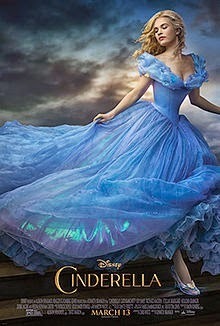Kristine Hughes's Blog, page 80
February 6, 2015
LOOSE IN LONDON: A RAINY DAY IN LONDONTOWN
Victoria here to tell you about our Monday the first of September 2014. And there we were in London, just like we lived there, ready to run some errands...battling traffic, negotiating construction sites, and trying to remember which way to look before stepping off the curb.
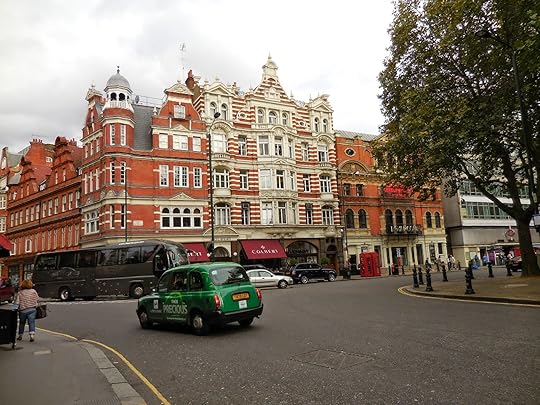 Sloane Square
Sloane Square
Our first errand was to find batteries for Kristine's Camera...a futile search as it turned out., But we started off from Sloane Square with all the energy we could muster, and boarded a bus for Tottenham Court Road, near some camera shops off Oxford Street.
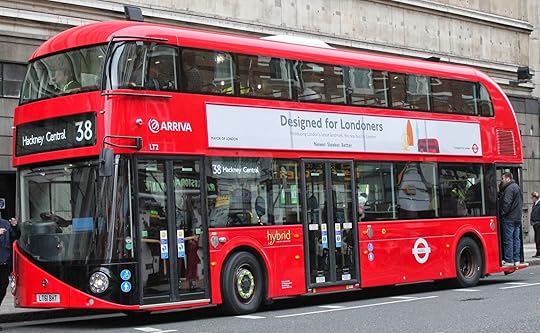 newest versions of the red London busses
newest versions of the red London busses
Riding the bus is one of My Favorite Pastimes in London. Have you noticed what a long list this is? I love everything in London. The tube is usually more efficient, but the scenery is not much!
But, it was threatening rain. We all know that if you carry an umbrella, it won't be a deluge, but my umbrella was safely tucked away in the hotel. So first goal upon departing the bus at Oxford Street, was a cheap umbrella. And it worked, for the most part, We had a bit of drizzle now and then but by the time I juggled my purse, etc. and got the darn thing raised, it stopped. Hooray!

We ducked into a Primark store to check out shoes for Kristine's poor feet and for me to look for a purse of a size somewhere between a satchel so large it held everything and was so heavy I couldn't lift it -- and a petite evening bag, perfect for an evening soiree at the Palace (too bad the invitation got lost in the mail). We were both unsuccessful, for the most part, in finding what we wanted, though we had fun browsing around and trying on things. But onward for the primary purpose of the day.
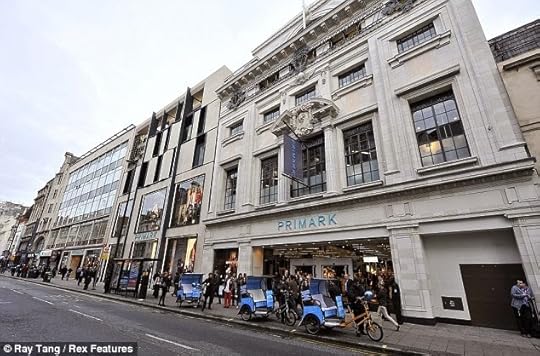 Primark
Primark
In the world of camera batteries, time had marched on from the last time Kristine had updated her photographic paraphernalia. Two stores said Nyet. But at the third, a nicely-priced new camera seemed to tempt her and she went into conference mode with the clerk.
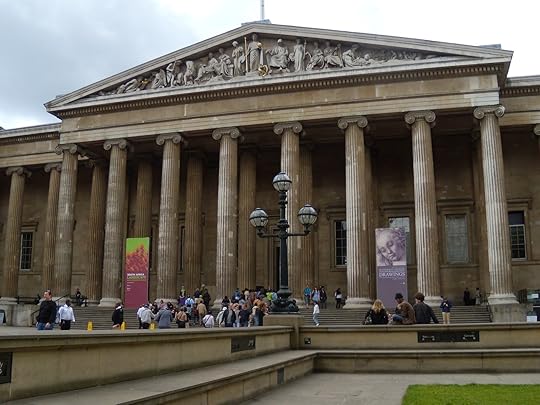 British Museum
British Museum
Meanwhile, I was getting anxious about getting to the British Museum, where I needed to go to the Print Study Room and access a couple of documents I wanted to photograph. So we made plans to meet up in the British Museum -- no problem finding a pal in there, right???
To make a long story short, I found my documents, got my pics, and we actually met up -- finding one another which was sort of a miracle since every single school child from France, Japan, and the U.S was in the museum that day.
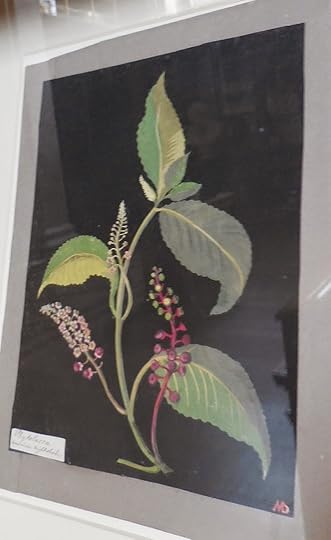 Paper mosaic by Mrs. Delaney
Paper mosaic by Mrs. Delaney
We took a quick walkabout in the Enlightenment Gallery (click here) about which I have written before on this blog, To see my remarks from 2012, click here.
However, hunger drove us to the Museum Tavern, a pub, where we have enjoyed ourselves before. The BM itself has lots of restaurants -- and lots of noisy customers. So we hurried across the street,and eagerly related our adventures, mine with the excellent service in the print room where I found exactly what I needed and Kristine's new camera in all its glory.
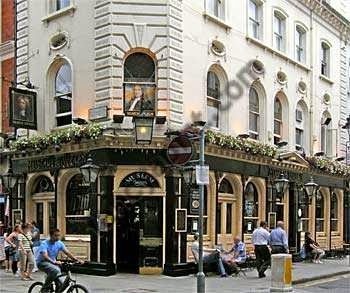 The Museum Tavern, an oasis indeed
The Museum Tavern, an oasis indeed
Kristine here: Picking up the story at the Museum Tavern, where we met and shared a table with an Englishman and his young son - as one does in London. We were forced, albeit gladly, to share the last table. We all ordered food - Victoria and I ordering the full English Breakfast - and three pints and then we were off, talking about America, Churchill, the Duke of Wellington, house prices, and many other things that I can no longer recall. A great time was had by all.
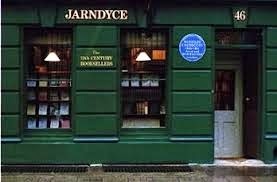
After lunch, we spent some time browsing at the Jarndyce Book and Print shop a few doors down and then we got a cab and rode back to the St. James's area, as Victoria and I wanted to finalize the route we'd be taking the tour group on for our Sunday St. James's Walk.
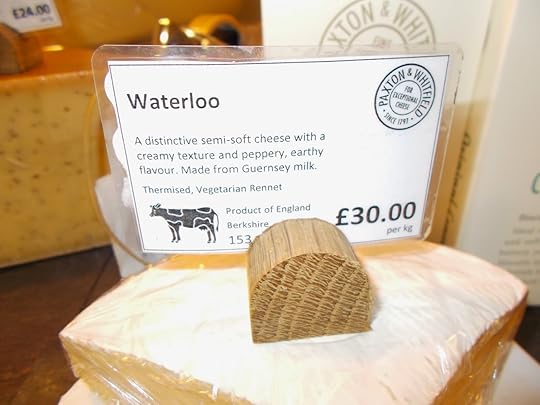
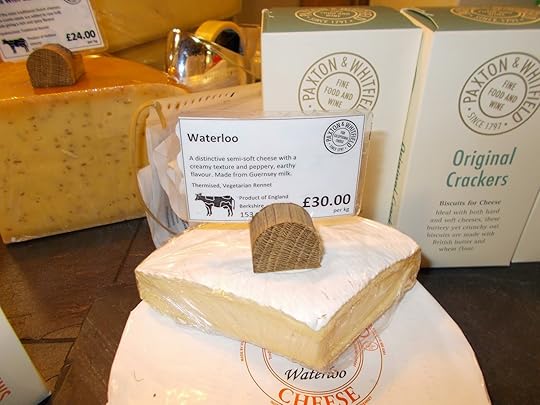
We made a few pit stops along the way, one of which was that venerable cheese shop, Paxton and Whitfield where we found Waterloo cheese! Thank goodness we had our cameras at the ready, or you'd never have believed it. Cheese.com tells us: Waterloo cheese is a mild, semi-soft cheese made by Anne and Andy Wigmore near Riseley, Berkshire in United Kingdom. The cheese is made from unpasteurised Guernsey milk sourced from a farm near Henley. A full-fat cheese, it has a fat content of 45%. Waterloo cheese is made using washed curd method, which tempers the acidity and contributes to a soft, gentle, buttery flavour. The characteristic yellow colour is due to the presence of natural carotene. The interiors have a creamy rich pate, slightly firm and flaky centre. The affinage period is between 4 and 10 weeks. Sarah Freedman, food writer and author of 'The Real Cheese Companion' has described Waterloo cheese as, “Waterloo is luscious and creamy with the sweetness of the rich milk and undertones of herbs and grass.”
Afterwards, we stopped into the atmospheric Three Crowns pub at 19 Babmaes Street and fortified ourselves with a rum and coke.
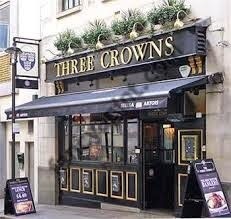
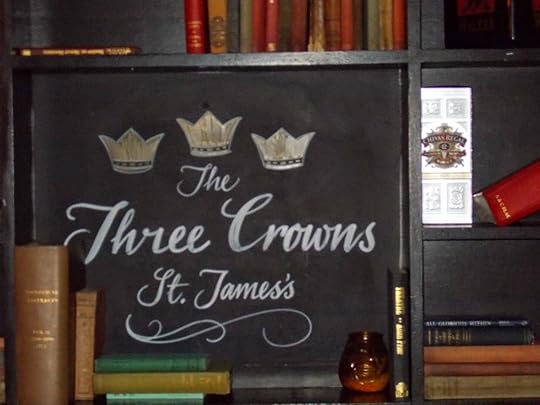
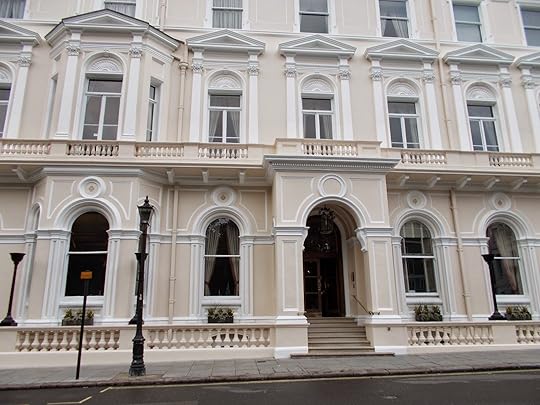
Eventually, we toddled our way over to St. James's Square in order to nail down which house had been the former home of the Boehm's, Number 16, where Henry Percy had delivered Wellington's Waterloo Dispatch and the captured French Eagles to the Prince Regent. Number 16, it turned out, is today part of the East India Club.
Victoria stood on the sidewalk and gazed up at the building. The East India Club. I thought of feats of derring do and exotic locales and the large piece of British military history that now loomed before us. Here's what the East India Club website has to say:
Waterloo 200 The original house in which the club was founded was noted for being the location where Wellington's dispatch from waterloo was presented to the Prince Regent. In honour of this unique connection the club is pleased to be a founder member of Wateroo 200. further details can be found by visiting www.waterloo200.org
"Let's go in," Victoria said, ever the risk taker.
"We can't!" I cried.
"Why ever not?" Victoria challenged.
"Er, because we're not men, we don't have waxed mustachios or pith helmets, or spiffy red uniforms and - most importantly - we're not members."
Victoria gave me a withering glance, "Since when has that ever stopped us?"
She had a point, and so we climbed the stairs, pushed the doors open and walked into the oak paneled lobby. Surprisingly, once we'd explained the reasons for our desire to see the inside of the Club, the man on duty was only too happy to answer our questions. Unfortunately, the room in which the Despatch was actually delivered - the current Club library - was undergoing renovations and thus was off limits. However, our host pointed out a book about the Club's history and suggested that we sit on the leather couches and take our time looking through it.
After a while I began to wonder how the Club was still in existence.
"How is the Club still in existence?" I asked Victoria.
"What?"
"The East India Company is long gone, right? It was the members of that Company and those affiliated with it who were members of the original Club. If there's no long an East India Company, where do they find members?"
It turns out that we found the answer a few pages on in the book:
All applications must be from gentlemen 18 years of age or older and must be presented on the official application form available from the Membership Secretary's office or by downloading it here
The categories of membership are Town, Country and Overseas, and the rates vary according to category and age. Town membership applies to gentlemen who either have a residence or a place of business within a 50-mile radius of the clubhouse. In accordance with its constitution, membership of the East India is available only to gentlemen.

Leaving the Club, we walked some ways down the Square until we found this blue plaque to Byron's daughter. It was whilst we were discussing Ada that a very dapper gentleman exited one of the houses and came to speak of us. He was Greek, but spoke perfect English and launched into fascinating detail regarding Byron and Ada. Victoria and I were enraptured. He then asked what had brought us to England and we told him about the Duke of Wellington Tour. This provided many more minutes of conversation between ourselves and the handsome, well turned out stranger. We were charmed . . . . . until of a sudden, his countenance hardened and, like the veriest religious zealot, he launched into a sermon on the evils of the world and how, in fact, the end of the world was near. Victoria and I exchanged sideways glances as he urged us to repent in order to secure our places at the second coming. With great haste, Victoria and I suddenly remembered an enormously important appointment that we were now quite late for and we took our leave just as fast as our confused little feet could carry us.
It was a good thing that we were to meet two of the tour participants that night, Diane Perkins and Marilyn Gaston, for dinner at the Duke of Wellington Pub. By my reckoning, that made three pubs we'd be visiting that day and, boy, did Victoria and I need a drink by the time we'd fled St. James's Square.
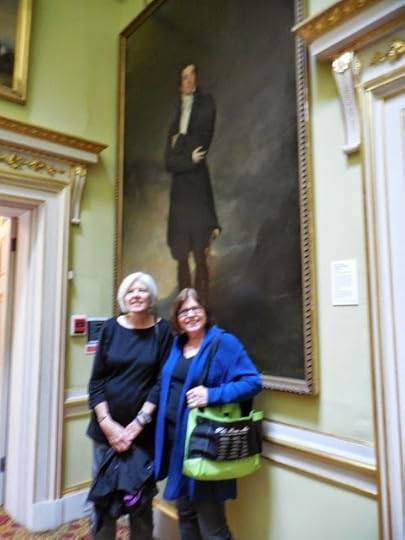
Victoria and I, Marilyn and Diane (author Diane Gaston) had a great meal, many drinks, lots of Wellington talk and more laughs than could be considered decent by polite society.
More Loose in London Coming Soon!
 Sloane Square
Sloane SquareOur first errand was to find batteries for Kristine's Camera...a futile search as it turned out., But we started off from Sloane Square with all the energy we could muster, and boarded a bus for Tottenham Court Road, near some camera shops off Oxford Street.
 newest versions of the red London busses
newest versions of the red London bussesRiding the bus is one of My Favorite Pastimes in London. Have you noticed what a long list this is? I love everything in London. The tube is usually more efficient, but the scenery is not much!
But, it was threatening rain. We all know that if you carry an umbrella, it won't be a deluge, but my umbrella was safely tucked away in the hotel. So first goal upon departing the bus at Oxford Street, was a cheap umbrella. And it worked, for the most part, We had a bit of drizzle now and then but by the time I juggled my purse, etc. and got the darn thing raised, it stopped. Hooray!

We ducked into a Primark store to check out shoes for Kristine's poor feet and for me to look for a purse of a size somewhere between a satchel so large it held everything and was so heavy I couldn't lift it -- and a petite evening bag, perfect for an evening soiree at the Palace (too bad the invitation got lost in the mail). We were both unsuccessful, for the most part, in finding what we wanted, though we had fun browsing around and trying on things. But onward for the primary purpose of the day.
 Primark
PrimarkIn the world of camera batteries, time had marched on from the last time Kristine had updated her photographic paraphernalia. Two stores said Nyet. But at the third, a nicely-priced new camera seemed to tempt her and she went into conference mode with the clerk.
 British Museum
British MuseumMeanwhile, I was getting anxious about getting to the British Museum, where I needed to go to the Print Study Room and access a couple of documents I wanted to photograph. So we made plans to meet up in the British Museum -- no problem finding a pal in there, right???
To make a long story short, I found my documents, got my pics, and we actually met up -- finding one another which was sort of a miracle since every single school child from France, Japan, and the U.S was in the museum that day.
 Paper mosaic by Mrs. Delaney
Paper mosaic by Mrs. DelaneyWe took a quick walkabout in the Enlightenment Gallery (click here) about which I have written before on this blog, To see my remarks from 2012, click here.
However, hunger drove us to the Museum Tavern, a pub, where we have enjoyed ourselves before. The BM itself has lots of restaurants -- and lots of noisy customers. So we hurried across the street,and eagerly related our adventures, mine with the excellent service in the print room where I found exactly what I needed and Kristine's new camera in all its glory.
 The Museum Tavern, an oasis indeed
The Museum Tavern, an oasis indeedKristine here: Picking up the story at the Museum Tavern, where we met and shared a table with an Englishman and his young son - as one does in London. We were forced, albeit gladly, to share the last table. We all ordered food - Victoria and I ordering the full English Breakfast - and three pints and then we were off, talking about America, Churchill, the Duke of Wellington, house prices, and many other things that I can no longer recall. A great time was had by all.

After lunch, we spent some time browsing at the Jarndyce Book and Print shop a few doors down and then we got a cab and rode back to the St. James's area, as Victoria and I wanted to finalize the route we'd be taking the tour group on for our Sunday St. James's Walk.


We made a few pit stops along the way, one of which was that venerable cheese shop, Paxton and Whitfield where we found Waterloo cheese! Thank goodness we had our cameras at the ready, or you'd never have believed it. Cheese.com tells us: Waterloo cheese is a mild, semi-soft cheese made by Anne and Andy Wigmore near Riseley, Berkshire in United Kingdom. The cheese is made from unpasteurised Guernsey milk sourced from a farm near Henley. A full-fat cheese, it has a fat content of 45%. Waterloo cheese is made using washed curd method, which tempers the acidity and contributes to a soft, gentle, buttery flavour. The characteristic yellow colour is due to the presence of natural carotene. The interiors have a creamy rich pate, slightly firm and flaky centre. The affinage period is between 4 and 10 weeks. Sarah Freedman, food writer and author of 'The Real Cheese Companion' has described Waterloo cheese as, “Waterloo is luscious and creamy with the sweetness of the rich milk and undertones of herbs and grass.”
Afterwards, we stopped into the atmospheric Three Crowns pub at 19 Babmaes Street and fortified ourselves with a rum and coke.



Eventually, we toddled our way over to St. James's Square in order to nail down which house had been the former home of the Boehm's, Number 16, where Henry Percy had delivered Wellington's Waterloo Dispatch and the captured French Eagles to the Prince Regent. Number 16, it turned out, is today part of the East India Club.
Victoria stood on the sidewalk and gazed up at the building. The East India Club. I thought of feats of derring do and exotic locales and the large piece of British military history that now loomed before us. Here's what the East India Club website has to say:
Waterloo 200 The original house in which the club was founded was noted for being the location where Wellington's dispatch from waterloo was presented to the Prince Regent. In honour of this unique connection the club is pleased to be a founder member of Wateroo 200. further details can be found by visiting www.waterloo200.org
"Let's go in," Victoria said, ever the risk taker.
"We can't!" I cried.
"Why ever not?" Victoria challenged.
"Er, because we're not men, we don't have waxed mustachios or pith helmets, or spiffy red uniforms and - most importantly - we're not members."
Victoria gave me a withering glance, "Since when has that ever stopped us?"
She had a point, and so we climbed the stairs, pushed the doors open and walked into the oak paneled lobby. Surprisingly, once we'd explained the reasons for our desire to see the inside of the Club, the man on duty was only too happy to answer our questions. Unfortunately, the room in which the Despatch was actually delivered - the current Club library - was undergoing renovations and thus was off limits. However, our host pointed out a book about the Club's history and suggested that we sit on the leather couches and take our time looking through it.
After a while I began to wonder how the Club was still in existence.
"How is the Club still in existence?" I asked Victoria.
"What?"
"The East India Company is long gone, right? It was the members of that Company and those affiliated with it who were members of the original Club. If there's no long an East India Company, where do they find members?"
It turns out that we found the answer a few pages on in the book:
All applications must be from gentlemen 18 years of age or older and must be presented on the official application form available from the Membership Secretary's office or by downloading it here
The categories of membership are Town, Country and Overseas, and the rates vary according to category and age. Town membership applies to gentlemen who either have a residence or a place of business within a 50-mile radius of the clubhouse. In accordance with its constitution, membership of the East India is available only to gentlemen.

Leaving the Club, we walked some ways down the Square until we found this blue plaque to Byron's daughter. It was whilst we were discussing Ada that a very dapper gentleman exited one of the houses and came to speak of us. He was Greek, but spoke perfect English and launched into fascinating detail regarding Byron and Ada. Victoria and I were enraptured. He then asked what had brought us to England and we told him about the Duke of Wellington Tour. This provided many more minutes of conversation between ourselves and the handsome, well turned out stranger. We were charmed . . . . . until of a sudden, his countenance hardened and, like the veriest religious zealot, he launched into a sermon on the evils of the world and how, in fact, the end of the world was near. Victoria and I exchanged sideways glances as he urged us to repent in order to secure our places at the second coming. With great haste, Victoria and I suddenly remembered an enormously important appointment that we were now quite late for and we took our leave just as fast as our confused little feet could carry us.
It was a good thing that we were to meet two of the tour participants that night, Diane Perkins and Marilyn Gaston, for dinner at the Duke of Wellington Pub. By my reckoning, that made three pubs we'd be visiting that day and, boy, did Victoria and I need a drink by the time we'd fled St. James's Square.

Victoria and I, Marilyn and Diane (author Diane Gaston) had a great meal, many drinks, lots of Wellington talk and more laughs than could be considered decent by polite society.
More Loose in London Coming Soon!
Published on February 06, 2015 00:00
February 4, 2015
VIDEO WEDNESDAY: CINDERELLA
Published on February 04, 2015 00:00
February 2, 2015
CAVORTING WITH THE AUSTENS IN ENGLAND
Victoria here, reporting on a sidelight of our recent Duke of Wellington Tour...see multiple posts we have already published and will be covering in more depth in the next few months.
Neither Chawton nor Steventon was in my itinerary for my three weeks in England last summer, But wherever I went, I found bits of Austenalia at hand. I was surprised to see the shop closed, once Rohan's, which filled the ground floor of Henry Austen's former Henrietta Street house near Covent Garden.
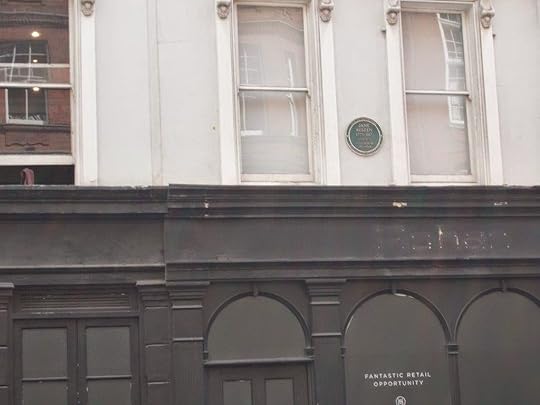
The Blue Plaque marking Jane Austen's visit was intact, but the building's fate could not be determined in late August. If anyone hears what happens, please e-mail us!
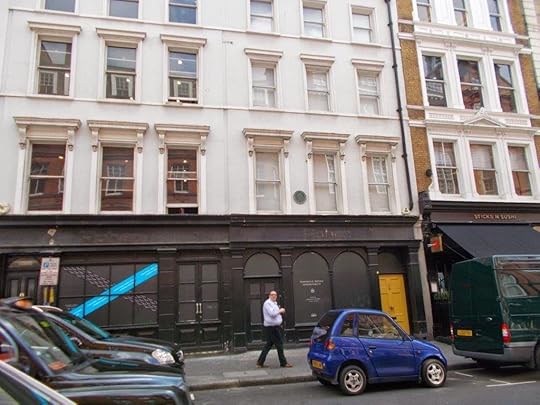 Henrietta Street
Henrietta Street
Wandering through London, I found myself in Cheapside, where the Gardiners lived in Pride and Prejudice, and took the opportunity of visiting St. Mary-le-Bow.
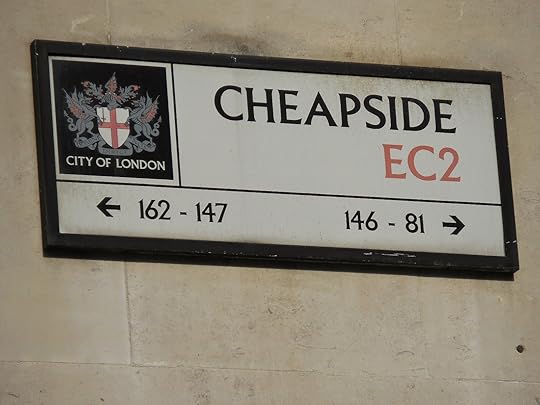
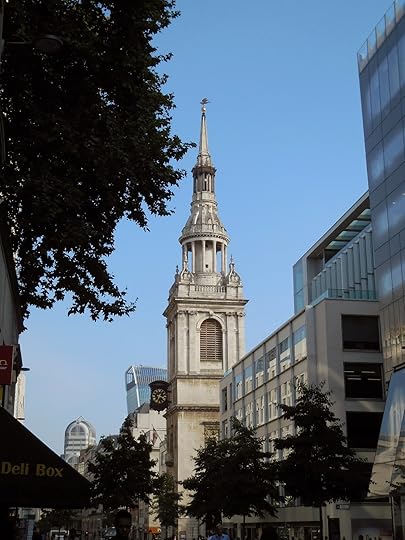 St. Mary-le-Bow
St. Mary-le-Bow
To be a real Cockney, it is said, one must be born withing the sound of Bow Bells.

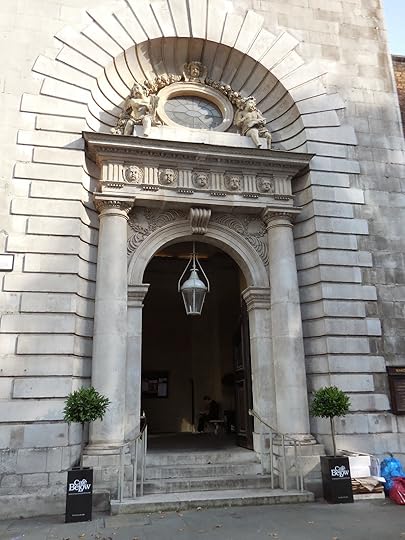
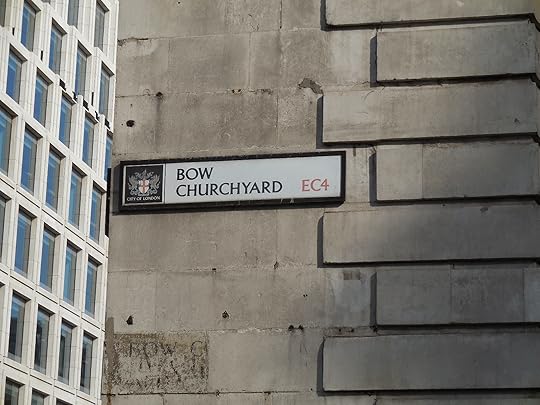
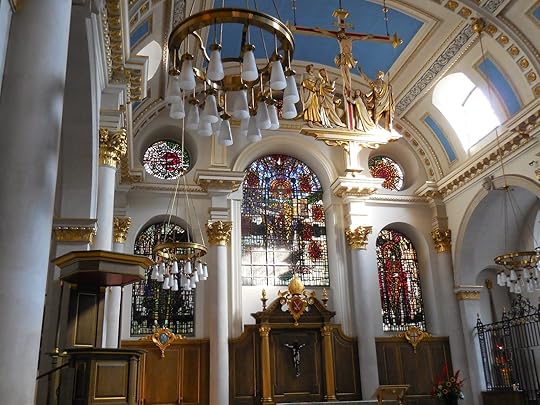 Altar, St. Mary-le-Bow
Altar, St. Mary-le-Bow
During London Open City Days, we toured the Foreign and Commonwealth Office Building, a place of many architectural wonders. In Dunbar Court, formerly the India Office, I found a statue of Warren Hastings, Governor-General of Bengal 1773-1785. Hastings is sometimes alleged to be the natural father of Jane Austen's cousin, Elize de Feuillide, who named her only son after him.
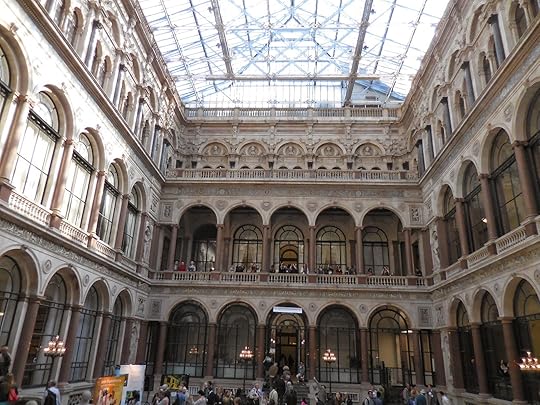 Dunbar Court
Dunbar Court
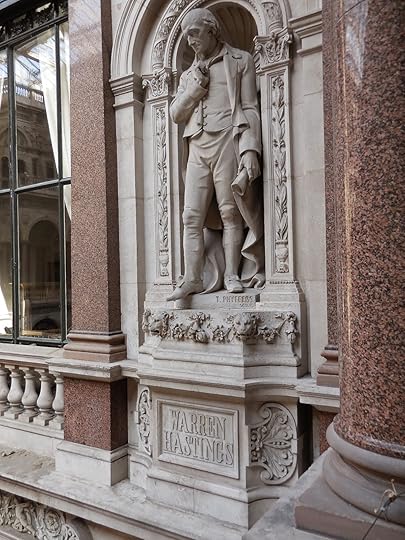 Warren Hastings statue in Dunbar Court
Warren Hastings statue in Dunbar Court
Imagine my surprise when came upon the graves in Hamsptead of Eliza, her son, and her mother.

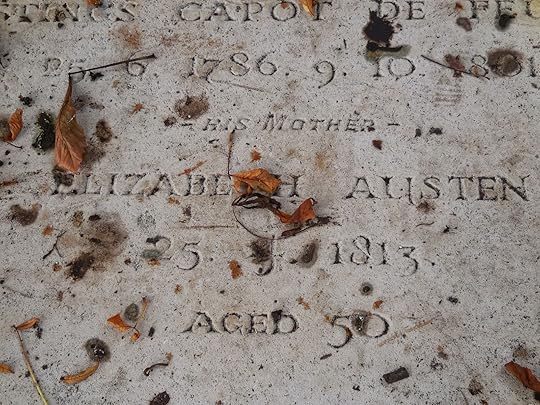
The gravestone, at St. John-at-Hampstead church, appeared tro be recently cleaned. It honors Philadelphia Hancock (d. 1792, age 61), her grandson Hastings (d. 1801, age six), and Elizabeth Austen (Eliza Hancock de Feuillide Austen), who was the wife of Jane's brother Henry Austen. died at age 50 in 1813.
.
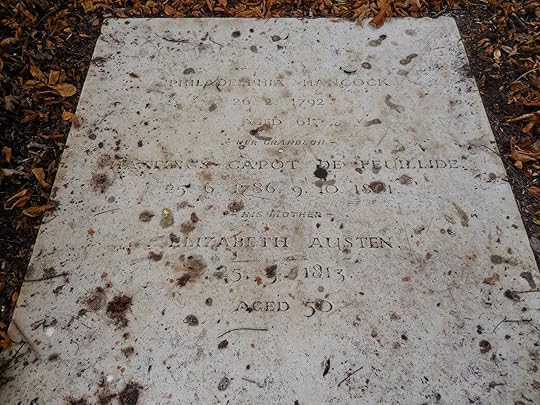
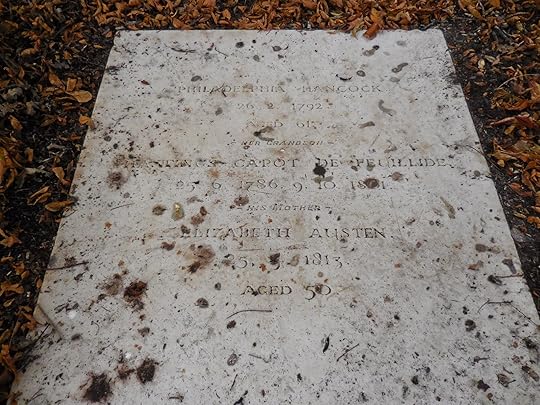
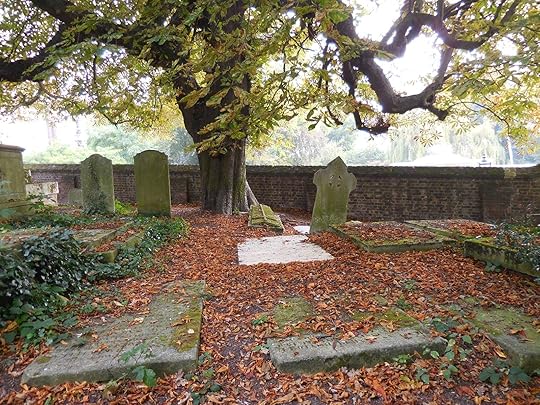 The lovely setting of the grave.
The lovely setting of the grave.
We visited Reading, in Berkshire, where we met author Beth Elliott, who is lucky enough to live nearby. Click here for her website and news of her books.
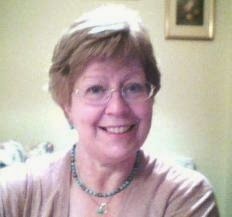 Beth Elliott, Author of Regency Tales
Beth Elliott, Author of Regency Tales
Beth kindly led us on a tour of the Forbury Gardens and the ruins of the Abbey.
 Here, in the Abbey Gate, Jane Austen and her sister Cassandra attended a school about 1785.
Here, in the Abbey Gate, Jane Austen and her sister Cassandra attended a school about 1785.
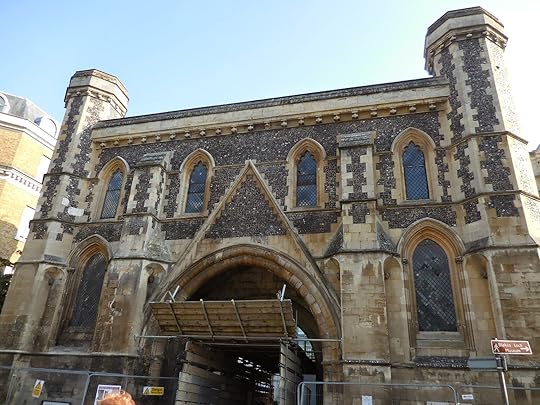
Reading Abbey was founded in 1121 by King Henry I, youngest son of William the Conqueror. Igt was an important royal site for centuries until the Dissolution of the Monasteries by Henry VIII in 1539.
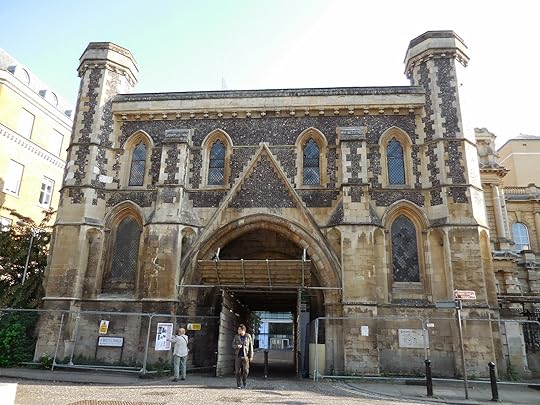
Considerable damage has occurred over the years, particularly from water. Currently, repairs are planned for the entire abbey complex, of which this is the only remaining intact building.
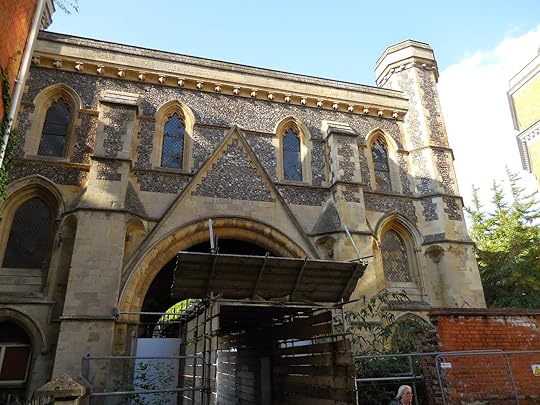
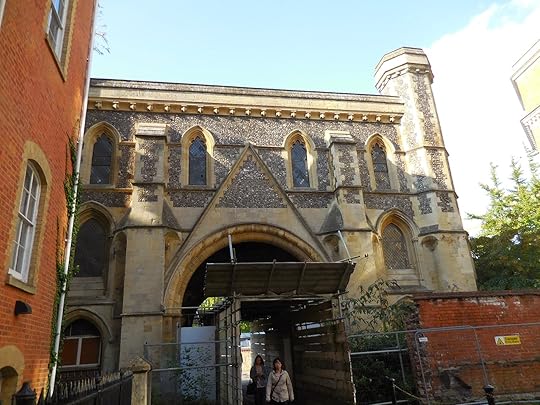
A fine series of carvings,called headstops, graced the building. I could not find identifications but one might assume they are kings, queens and saints????
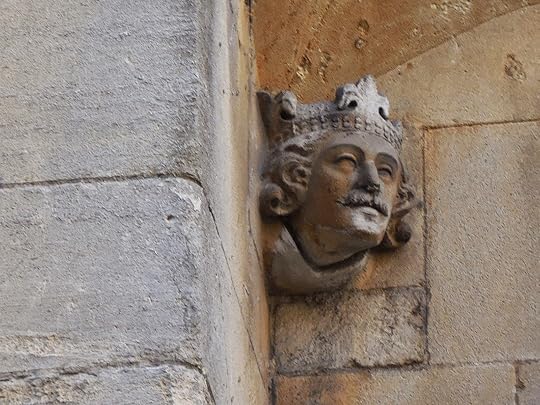
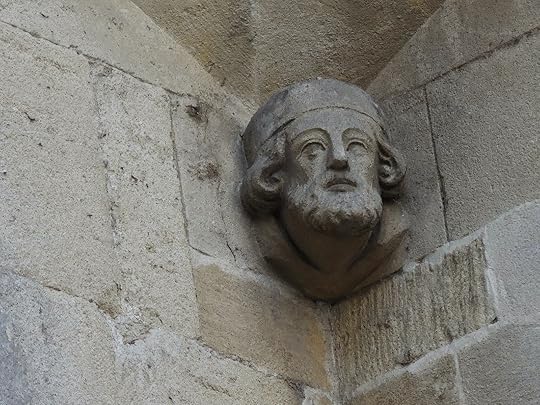
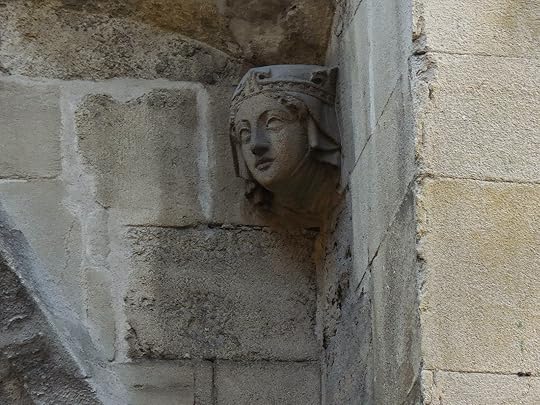
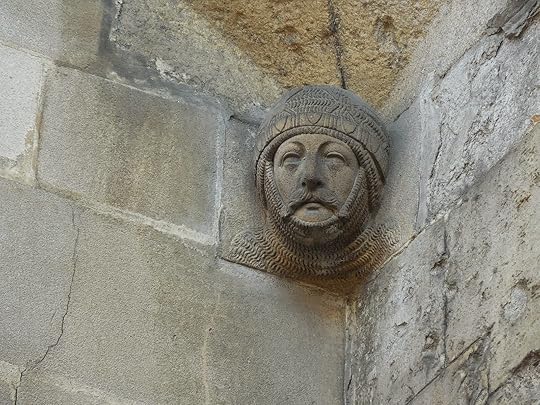
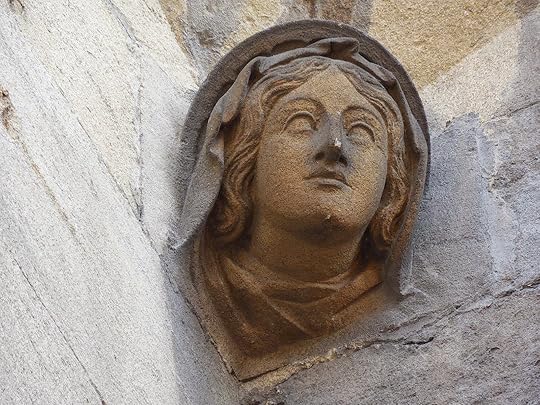
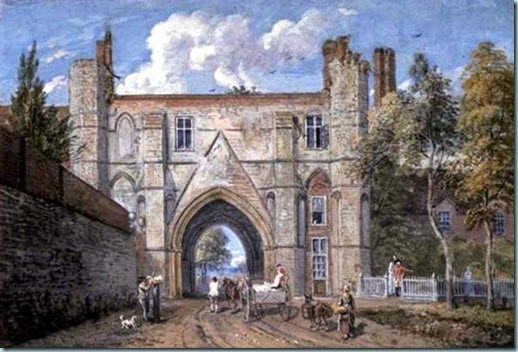 18th Century view of the Abbey Gate before it was "tarted up" by Sir Gilbert Scott in the Victorian era.
18th Century view of the Abbey Gate before it was "tarted up" by Sir Gilbert Scott in the Victorian era.
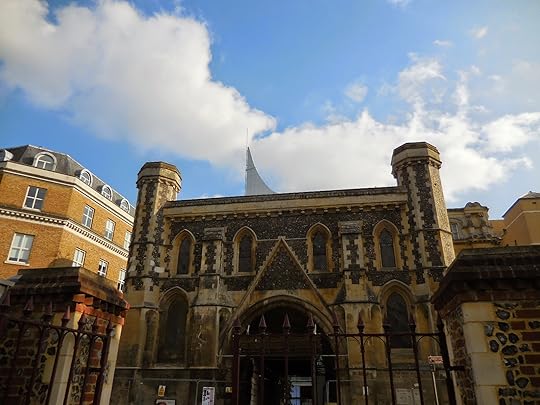
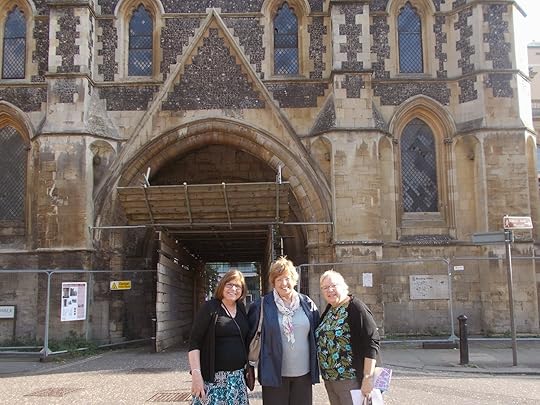 Authors and Austen lovers Diane Gaston, Beth Elliott and Victoria Hinshaw
Authors and Austen lovers Diane Gaston, Beth Elliott and Victoria Hinshaw
Forbury Gardens overflowed with beautiful flower beds in the September sunshine.


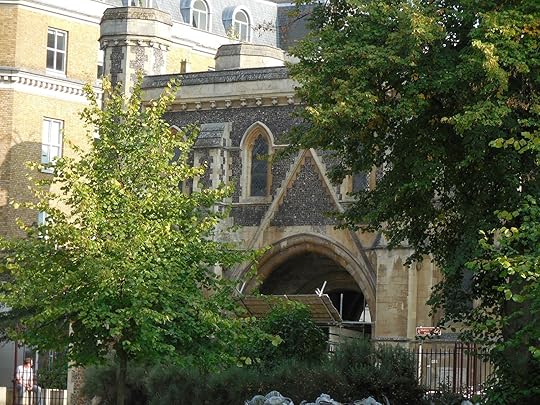 A pretty view in which the trees block most of the construction.
A pretty view in which the trees block most of the construction.
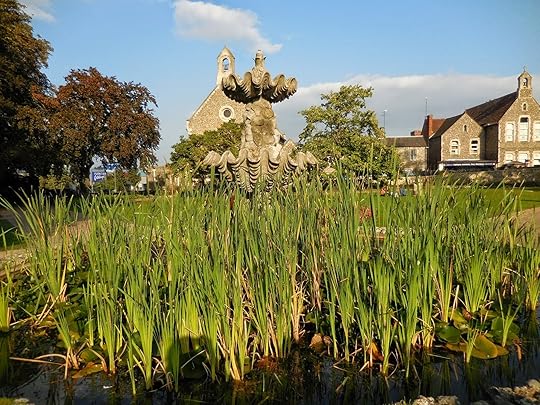
Most of the ruins of Reading Abbey are currently fenced off and inaccessible. Repairs are underway.
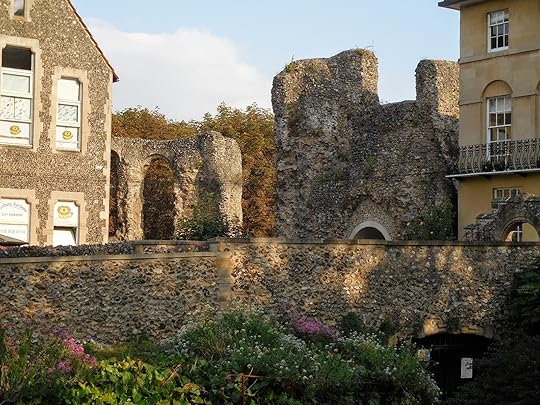
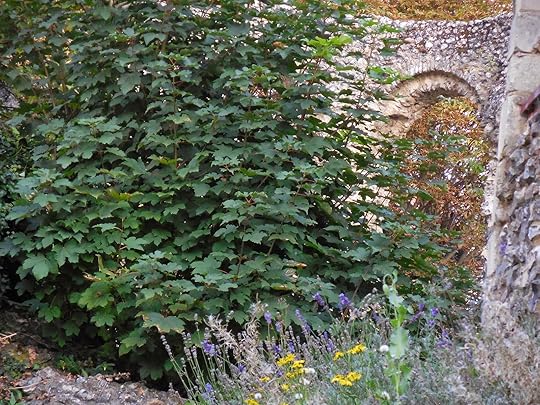
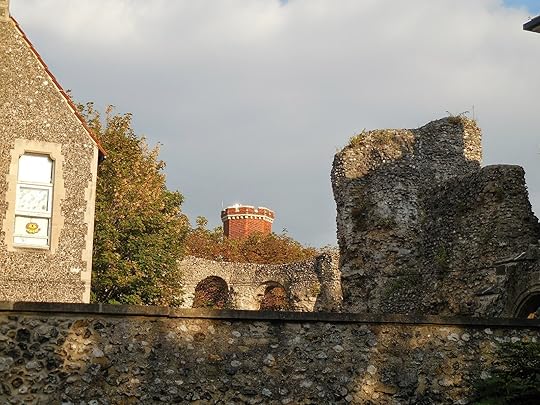
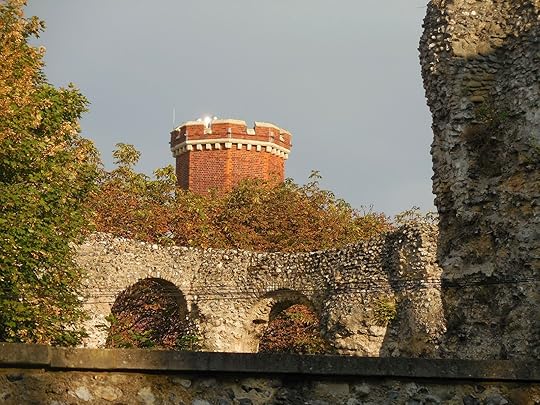 The reddish tower, while picturesque, has nothing to do with the Abbey ruins!
The reddish tower, while picturesque, has nothing to do with the Abbey ruins!
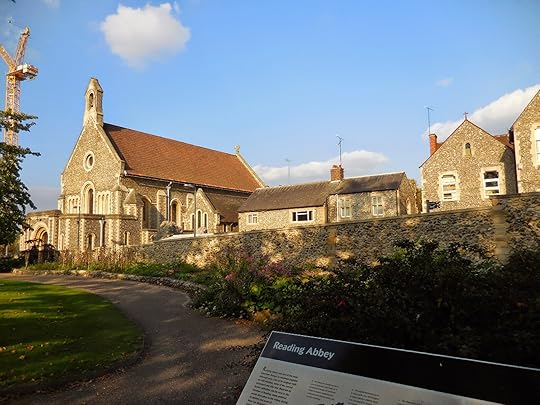 Many of the nearby buildings were constructed of stones and rubble from the Abbey ruins.
Many of the nearby buildings were constructed of stones and rubble from the Abbey ruins.
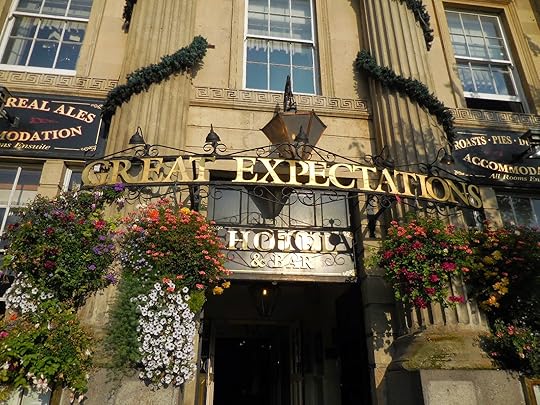 Great Expectations, where Beth is fortunate enough to hold her critique group sessions.
Great Expectations, where Beth is fortunate enough to hold her critique group sessions.
After our day tramping around several estates then the Abbey ruins, we were delighted to retire with Beth Elliott to a local establishment for a little rest and relaxation.
My Austen Encounters were a great bonus to our Duke of Wellington tour, unforeseen but entirely welcome.
Neither Chawton nor Steventon was in my itinerary for my three weeks in England last summer, But wherever I went, I found bits of Austenalia at hand. I was surprised to see the shop closed, once Rohan's, which filled the ground floor of Henry Austen's former Henrietta Street house near Covent Garden.

The Blue Plaque marking Jane Austen's visit was intact, but the building's fate could not be determined in late August. If anyone hears what happens, please e-mail us!
 Henrietta Street
Henrietta StreetWandering through London, I found myself in Cheapside, where the Gardiners lived in Pride and Prejudice, and took the opportunity of visiting St. Mary-le-Bow.

 St. Mary-le-Bow
St. Mary-le-BowTo be a real Cockney, it is said, one must be born withing the sound of Bow Bells.



 Altar, St. Mary-le-Bow
Altar, St. Mary-le-BowDuring London Open City Days, we toured the Foreign and Commonwealth Office Building, a place of many architectural wonders. In Dunbar Court, formerly the India Office, I found a statue of Warren Hastings, Governor-General of Bengal 1773-1785. Hastings is sometimes alleged to be the natural father of Jane Austen's cousin, Elize de Feuillide, who named her only son after him.
 Dunbar Court
Dunbar Court Warren Hastings statue in Dunbar Court
Warren Hastings statue in Dunbar CourtImagine my surprise when came upon the graves in Hamsptead of Eliza, her son, and her mother.


The gravestone, at St. John-at-Hampstead church, appeared tro be recently cleaned. It honors Philadelphia Hancock (d. 1792, age 61), her grandson Hastings (d. 1801, age six), and Elizabeth Austen (Eliza Hancock de Feuillide Austen), who was the wife of Jane's brother Henry Austen. died at age 50 in 1813.
.


 The lovely setting of the grave.
The lovely setting of the grave.We visited Reading, in Berkshire, where we met author Beth Elliott, who is lucky enough to live nearby. Click here for her website and news of her books.
 Beth Elliott, Author of Regency Tales
Beth Elliott, Author of Regency TalesBeth kindly led us on a tour of the Forbury Gardens and the ruins of the Abbey.
 Here, in the Abbey Gate, Jane Austen and her sister Cassandra attended a school about 1785.
Here, in the Abbey Gate, Jane Austen and her sister Cassandra attended a school about 1785. 
Reading Abbey was founded in 1121 by King Henry I, youngest son of William the Conqueror. Igt was an important royal site for centuries until the Dissolution of the Monasteries by Henry VIII in 1539.

Considerable damage has occurred over the years, particularly from water. Currently, repairs are planned for the entire abbey complex, of which this is the only remaining intact building.


A fine series of carvings,called headstops, graced the building. I could not find identifications but one might assume they are kings, queens and saints????





 18th Century view of the Abbey Gate before it was "tarted up" by Sir Gilbert Scott in the Victorian era.
18th Century view of the Abbey Gate before it was "tarted up" by Sir Gilbert Scott in the Victorian era.
 Authors and Austen lovers Diane Gaston, Beth Elliott and Victoria Hinshaw
Authors and Austen lovers Diane Gaston, Beth Elliott and Victoria HinshawForbury Gardens overflowed with beautiful flower beds in the September sunshine.


 A pretty view in which the trees block most of the construction.
A pretty view in which the trees block most of the construction.
Most of the ruins of Reading Abbey are currently fenced off and inaccessible. Repairs are underway.



 The reddish tower, while picturesque, has nothing to do with the Abbey ruins!
The reddish tower, while picturesque, has nothing to do with the Abbey ruins! Many of the nearby buildings were constructed of stones and rubble from the Abbey ruins.
Many of the nearby buildings were constructed of stones and rubble from the Abbey ruins. Great Expectations, where Beth is fortunate enough to hold her critique group sessions.
Great Expectations, where Beth is fortunate enough to hold her critique group sessions.After our day tramping around several estates then the Abbey ruins, we were delighted to retire with Beth Elliott to a local establishment for a little rest and relaxation.
My Austen Encounters were a great bonus to our Duke of Wellington tour, unforeseen but entirely welcome.
Published on February 02, 2015 00:00
January 29, 2015
LOOSE IN LONDON: A VISIT TO CLARENCE HOUSE
Victoria here, inviting you to our take on Clarence House, London,. Kristine and I booked our tour while the current residents, the Prince of Wales and his wife, Camilla, Duchess of Cornwall, were off on vacation.
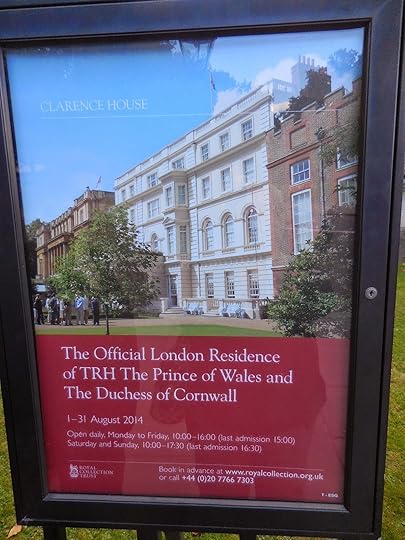 Poster advertising the summer opening of Clarence House
Poster advertising the summer opening of Clarence House
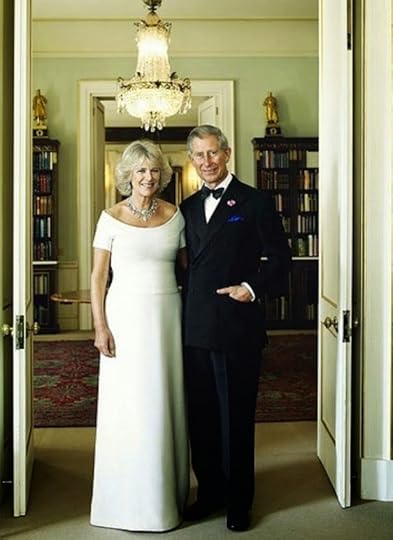 This was not the greeting we received when we arrived. Oh, well.
This was not the greeting we received when we arrived. Oh, well.
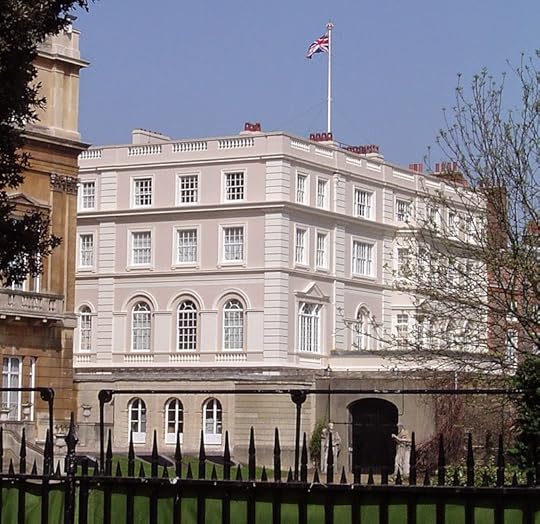 Clarence House is located adjacent to St. James's Palace (redbrick, on the far right) and next to Lancaster House, on the left.
Clarence House is located adjacent to St. James's Palace (redbrick, on the far right) and next to Lancaster House, on the left.
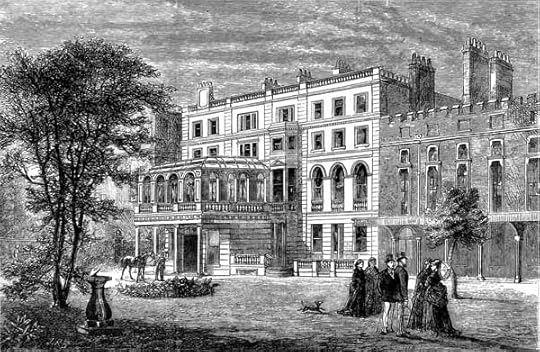 1874 engraving of Clarence House
1874 engraving of Clarence House
Clarence House , designed by John Nash,was built for the Duke of Clarence between 1825 and 1827. After the death of his elder brother, George IV, the duke became King William IV in 1830. He and his wife, Queen Adelaide, continued to live in Clarence House until his death in 1837.
George IV's extensive plans with Nash for remodeling Buckingham Palace were not finished at the king's death. According to Wikipedia, "Unlike his elder brother George IV, the Duke of Clarence was not a connoisseur of art and fine furnishings. The interior of Clarence House was plainly decorated and furnished in comparison to Buckingham Palace and York House."
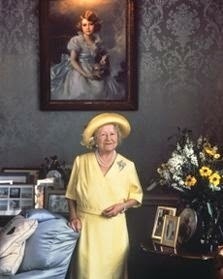 Queen Elizabeth, The Queen Mother, lived at Clarence House from 1953 until her death in 2002 at age 101.
Queen Elizabeth, The Queen Mother, lived at Clarence House from 1953 until her death in 2002 at age 101.
 The Morning RoomPortrait of Princess Elizabeth, 1933 by Philip de Laszlo
The Morning RoomPortrait of Princess Elizabeth, 1933 by Philip de Laszlo
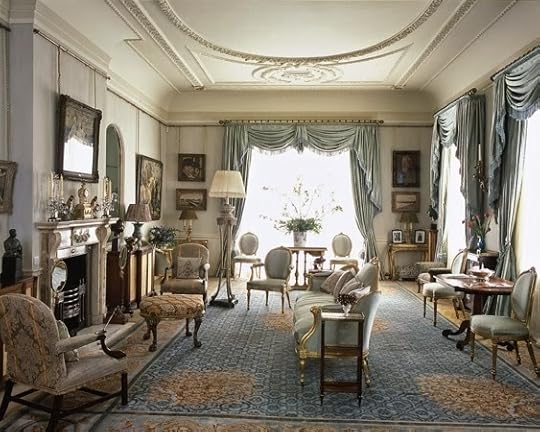 The Morning Room, current photo
The Morning Room, current photo
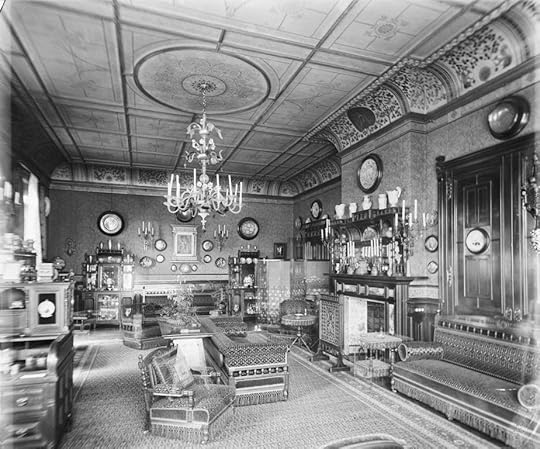 The Morning Room 1870's; photo by Horatio N. KingRoyal Collection Trust/© Her Majesty Queen Elizabeth II 2014
The Morning Room 1870's; photo by Horatio N. KingRoyal Collection Trust/© Her Majesty Queen Elizabeth II 2014
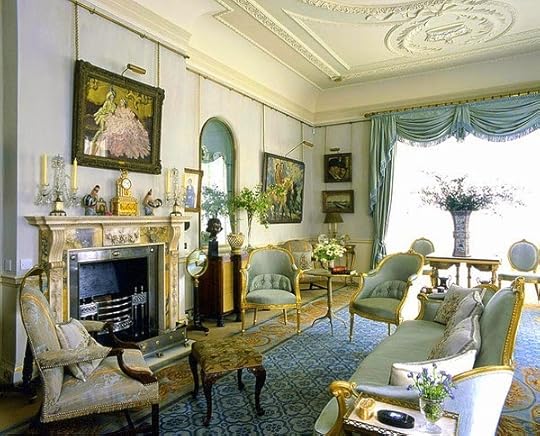 The Morning Room is pretty in blue,
The Morning Room is pretty in blue,
The tour of Clarence House takes in only a few rooms on the ground floor. The Morning Room was the most attractive, and very feminine, as if a cloud of little princesses would materialize in their billowy organza gowns at any moment.
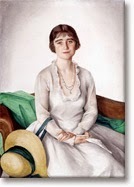
The Mystery Portrait? Seems obvious to us: it is Queen Elizabeth, the Queen MotherBut both Kristine and I are positive the guide told a story about it being a portrait of Princess Elizabeth by artist Augustus Strong who was in such awe of the sitter that he made her look awkward. When I was surfing the web for more info, I found another blog post on a visit to Clarence House that told the same story about the painting. Must have been the same guide, the same misinformed guide,
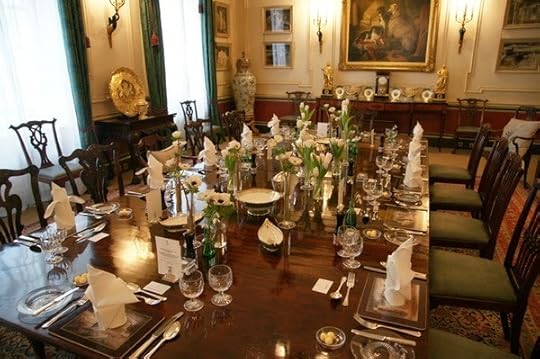 Dining Room
Dining Room
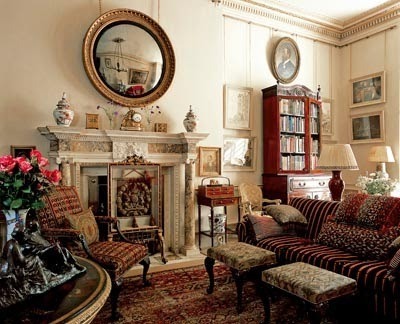 The Lancaster RoomI'm sorry to say I found this room almost claustrophobic with its crowded feeling and myriad designs. 'Less is more' was not the byword for the creator of this decor!
The Lancaster RoomI'm sorry to say I found this room almost claustrophobic with its crowded feeling and myriad designs. 'Less is more' was not the byword for the creator of this decor!
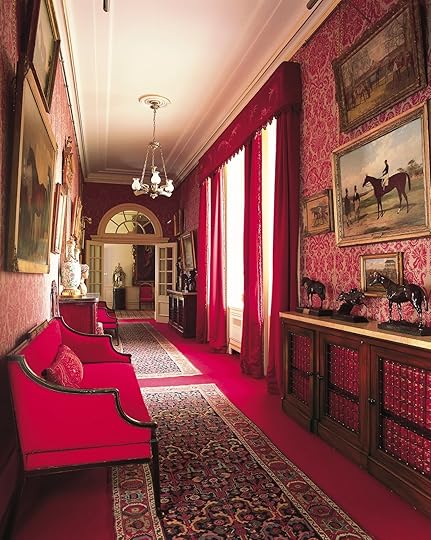 The Horse Corridor
The Horse Corridor
We know the Queen Mother was a horse lover and owner of a fine racing stable. This handsome corridor was a treasure trove for us horse-crazy types. For others, not so much.
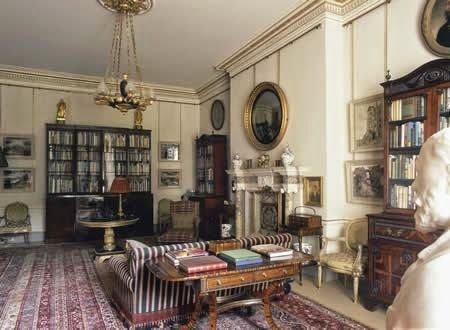 The Library
The Library
No pictures are allowed on the grounds or within Clarence House. These pictures come from official sources, but I feel quite sure that I could not have taken any more attractive. Which led us to the question: is this the place that royal artwork comes to die? While one would not exactly say it is shabby, it's not very elegant (other than the Morning Room). Yet it seems too formal for the residents to lounge around in their bathrobes and slippers. We did not get upstairs, however, which is where they probably relax.
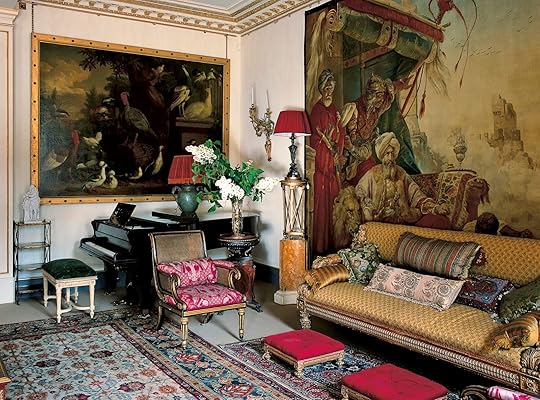 The Garden Room
The Garden Room
 Prince Charles in his pram at Clarence House, 1950Royal Collection Trust/© Her Majesty Queen Elizabeth II 2014
Prince Charles in his pram at Clarence House, 1950Royal Collection Trust/© Her Majesty Queen Elizabeth II 2014
Many members of the Royal Family have lived at Clarence House in its nearly 200-year history. Princess Elizabeth and Prince Philip, Duke of Edinburgh, lived here from 1949 until they moved to Buckingham Palace in 1952 when she became Queen. The Prince of Wales moved back to Clarence House in 2003 with his wife, Camilla, Duchess of Cornwall.
Prince Charles inspired a lovely garden, which seemed to have yielded considerable produce. Gardening and land use are among the Prince's favorite interests.
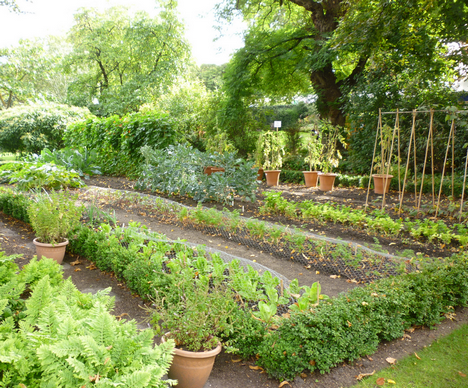
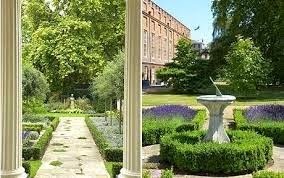 In this view from the entrance, the adjacent St. James's Palace is clearly evident.
In this view from the entrance, the adjacent St. James's Palace is clearly evident.
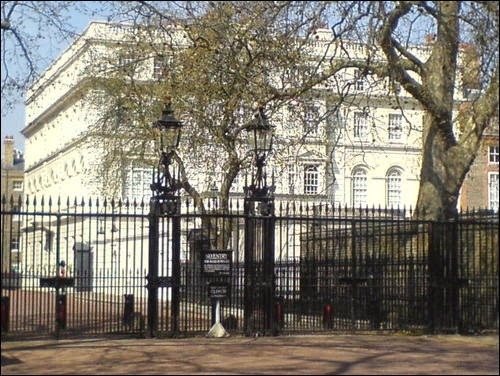 The View from the Mall
The View from the Mall
For more information on Clarence House, click here.
For Kristine and me, the visit only whetted our appetites for our visit to Buckingham Palace, coming soon.
 Poster advertising the summer opening of Clarence House
Poster advertising the summer opening of Clarence House This was not the greeting we received when we arrived. Oh, well.
This was not the greeting we received when we arrived. Oh, well. Clarence House is located adjacent to St. James's Palace (redbrick, on the far right) and next to Lancaster House, on the left.
Clarence House is located adjacent to St. James's Palace (redbrick, on the far right) and next to Lancaster House, on the left. 1874 engraving of Clarence House
1874 engraving of Clarence HouseClarence House , designed by John Nash,was built for the Duke of Clarence between 1825 and 1827. After the death of his elder brother, George IV, the duke became King William IV in 1830. He and his wife, Queen Adelaide, continued to live in Clarence House until his death in 1837.
George IV's extensive plans with Nash for remodeling Buckingham Palace were not finished at the king's death. According to Wikipedia, "Unlike his elder brother George IV, the Duke of Clarence was not a connoisseur of art and fine furnishings. The interior of Clarence House was plainly decorated and furnished in comparison to Buckingham Palace and York House."
 Queen Elizabeth, The Queen Mother, lived at Clarence House from 1953 until her death in 2002 at age 101.
Queen Elizabeth, The Queen Mother, lived at Clarence House from 1953 until her death in 2002 at age 101. The Morning RoomPortrait of Princess Elizabeth, 1933 by Philip de Laszlo
The Morning RoomPortrait of Princess Elizabeth, 1933 by Philip de Laszlo The Morning Room, current photo
The Morning Room, current photo The Morning Room 1870's; photo by Horatio N. KingRoyal Collection Trust/© Her Majesty Queen Elizabeth II 2014
The Morning Room 1870's; photo by Horatio N. KingRoyal Collection Trust/© Her Majesty Queen Elizabeth II 2014 The Morning Room is pretty in blue,
The Morning Room is pretty in blue,The tour of Clarence House takes in only a few rooms on the ground floor. The Morning Room was the most attractive, and very feminine, as if a cloud of little princesses would materialize in their billowy organza gowns at any moment.

The Mystery Portrait? Seems obvious to us: it is Queen Elizabeth, the Queen MotherBut both Kristine and I are positive the guide told a story about it being a portrait of Princess Elizabeth by artist Augustus Strong who was in such awe of the sitter that he made her look awkward. When I was surfing the web for more info, I found another blog post on a visit to Clarence House that told the same story about the painting. Must have been the same guide, the same misinformed guide,
 Dining Room
Dining Room The Lancaster RoomI'm sorry to say I found this room almost claustrophobic with its crowded feeling and myriad designs. 'Less is more' was not the byword for the creator of this decor!
The Lancaster RoomI'm sorry to say I found this room almost claustrophobic with its crowded feeling and myriad designs. 'Less is more' was not the byword for the creator of this decor! The Horse Corridor
The Horse CorridorWe know the Queen Mother was a horse lover and owner of a fine racing stable. This handsome corridor was a treasure trove for us horse-crazy types. For others, not so much.
 The Library
The LibraryNo pictures are allowed on the grounds or within Clarence House. These pictures come from official sources, but I feel quite sure that I could not have taken any more attractive. Which led us to the question: is this the place that royal artwork comes to die? While one would not exactly say it is shabby, it's not very elegant (other than the Morning Room). Yet it seems too formal for the residents to lounge around in their bathrobes and slippers. We did not get upstairs, however, which is where they probably relax.
 The Garden Room
The Garden Room Prince Charles in his pram at Clarence House, 1950Royal Collection Trust/© Her Majesty Queen Elizabeth II 2014
Prince Charles in his pram at Clarence House, 1950Royal Collection Trust/© Her Majesty Queen Elizabeth II 2014Many members of the Royal Family have lived at Clarence House in its nearly 200-year history. Princess Elizabeth and Prince Philip, Duke of Edinburgh, lived here from 1949 until they moved to Buckingham Palace in 1952 when she became Queen. The Prince of Wales moved back to Clarence House in 2003 with his wife, Camilla, Duchess of Cornwall.
Prince Charles inspired a lovely garden, which seemed to have yielded considerable produce. Gardening and land use are among the Prince's favorite interests.

 In this view from the entrance, the adjacent St. James's Palace is clearly evident.
In this view from the entrance, the adjacent St. James's Palace is clearly evident. The View from the Mall
The View from the MallFor more information on Clarence House, click here.
For Kristine and me, the visit only whetted our appetites for our visit to Buckingham Palace, coming soon.
Published on January 29, 2015 23:30
January 28, 2015
WATERLOO WEDNESDAY: GREYS AND GLORY
FROM THE BRITISH WEEKLY -THIS YEAR marks the 200th anniversary of the Battle of Waterloo, the epic climax to the Napoleonic war on Belgian soil that finally banished the spectre of French domination of the Continent and enshrined The Duke of Wellington’s place in history. Waterloo also ushered in a period of relative peace and prosperity among the major European nations that was not completely broken until the outbreak of World War One almost a century later.Not surprisingly there are countless events planned to mark the anniversary of this pivotal battle during the week of June 15-22nd. But one group with a local connection hoping to participate is the charity Greys & Glory, which is composed of active and former members of the Royal Scots Dragoon Guards and civilian members of the War Horse Foundation from Los Angeles.
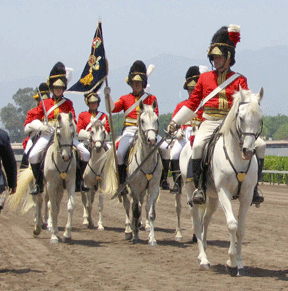 The War Horse Foundation has been presenting the 1815 Royal Scots Greys since 2002 at events including the Tournament of Roses Parade and numerous Scottish festivalsThe organizers of the charity hope to recreate the troupe of the Royal Scots Greys, a cavalry brigade sadly now defunct but whose name will be forever linked with many of the most famous chapters in British military history. The troupe was finally disbanded in 1971 after an illustrious history spanning almost three hundred years. It was the Greys who led a pivotal cavalry charge in support of the infantry during Waterloo and captured the French eagle standard from the formidable French 45th infantry division. An act immortalized in Lady Elizabeth Butler’s famous painting of the event.The War Horse Foundation has been presenting the 1815 Royal Scots Greys since 2002 at numerous events, Scottish Festivals and the Tournament of Roses Parade. And this summer the Greys and Glory troupe will be at Waterloo presenting to an anticipated 300,000 spectators and countless millions more watching around the world. During the ceremonies they plan to hold a separate event for the veterans and active service and public to attend, commemorating the Scots Greys by reading the names of the fallen riders.But the organization need to equip, refit, manufacture uniforms, gear and accoutrements for rider and horse. They also have to procure proper grey horses, suitable for presentation and the stimulus of guns and cannon fire. Getting the horses to Waterlool and maintaining their care is the biggest expense. They need help and donations. They are launching a crowfunding venture this month and will hold several fundraising events during the spring. To see how you can help, visitgreysandglory.org or warhorsefoundation.com. They can also be found on Facebook and can be reached at: 818 694-9277.Fritz Bronner, the Director of the War Horse & Militaria Heritage Foundation told the British Weekly this week: “As an American, (with Scottish, English and Welsh heritage)…. it is a great opportunity for all Americans to recognize the heritage of the Greys as well as say thank you to the current British Regiment and say “thank-you” to our closest, ally and friends; Great Britain. For the many British and Scottish ex-pats , it is a chance to share their heritage and patriotism to remember and commemorate British Soldiers past and present.”
The War Horse Foundation has been presenting the 1815 Royal Scots Greys since 2002 at events including the Tournament of Roses Parade and numerous Scottish festivalsThe organizers of the charity hope to recreate the troupe of the Royal Scots Greys, a cavalry brigade sadly now defunct but whose name will be forever linked with many of the most famous chapters in British military history. The troupe was finally disbanded in 1971 after an illustrious history spanning almost three hundred years. It was the Greys who led a pivotal cavalry charge in support of the infantry during Waterloo and captured the French eagle standard from the formidable French 45th infantry division. An act immortalized in Lady Elizabeth Butler’s famous painting of the event.The War Horse Foundation has been presenting the 1815 Royal Scots Greys since 2002 at numerous events, Scottish Festivals and the Tournament of Roses Parade. And this summer the Greys and Glory troupe will be at Waterloo presenting to an anticipated 300,000 spectators and countless millions more watching around the world. During the ceremonies they plan to hold a separate event for the veterans and active service and public to attend, commemorating the Scots Greys by reading the names of the fallen riders.But the organization need to equip, refit, manufacture uniforms, gear and accoutrements for rider and horse. They also have to procure proper grey horses, suitable for presentation and the stimulus of guns and cannon fire. Getting the horses to Waterlool and maintaining their care is the biggest expense. They need help and donations. They are launching a crowfunding venture this month and will hold several fundraising events during the spring. To see how you can help, visitgreysandglory.org or warhorsefoundation.com. They can also be found on Facebook and can be reached at: 818 694-9277.Fritz Bronner, the Director of the War Horse & Militaria Heritage Foundation told the British Weekly this week: “As an American, (with Scottish, English and Welsh heritage)…. it is a great opportunity for all Americans to recognize the heritage of the Greys as well as say thank you to the current British Regiment and say “thank-you” to our closest, ally and friends; Great Britain. For the many British and Scottish ex-pats , it is a chance to share their heritage and patriotism to remember and commemorate British Soldiers past and present.”
Published on January 28, 2015 00:00
January 25, 2015
LOOSE IN LONDON: FROM THE RIVER TO CLARENCE HOUSE
As you'll recall, Victoria and I lucked out with gorgeous weather for our mudlarking adventure.
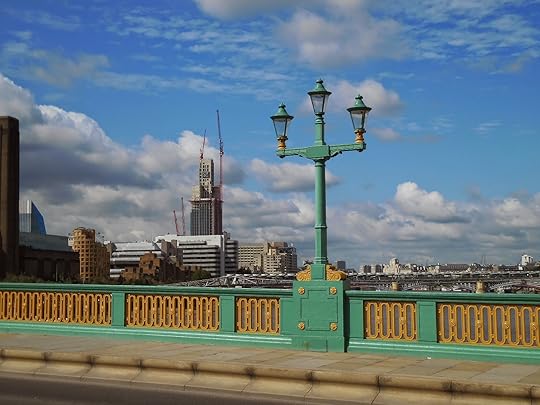
Looking in both directions from the Southwark Bridge
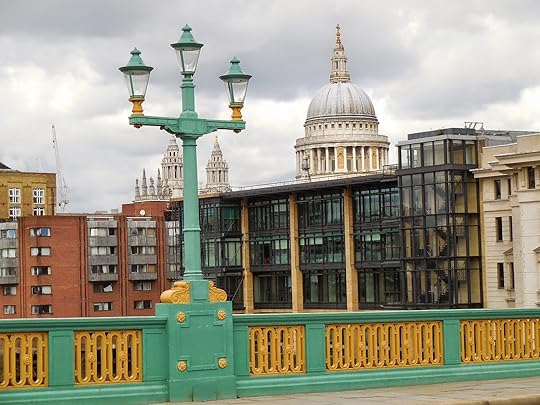
We decided to up towards Gabriel Wharf for a bite of lunch and on our way we passed a few landmarks you may recognize.
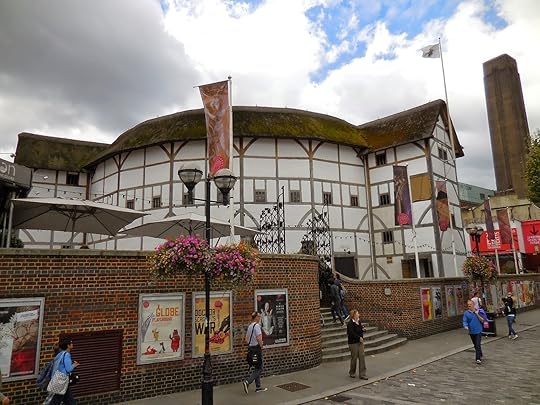
The Globe Theatre
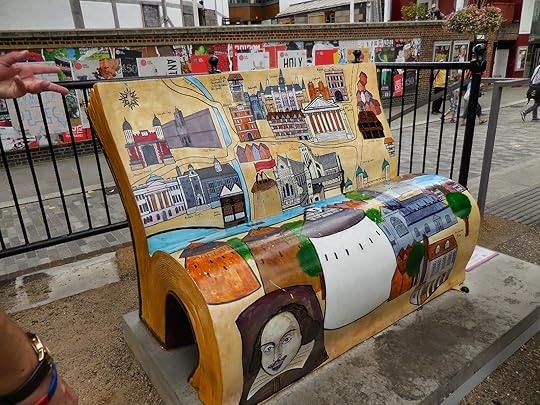
with Shakespeare's bench on the pavement out front.
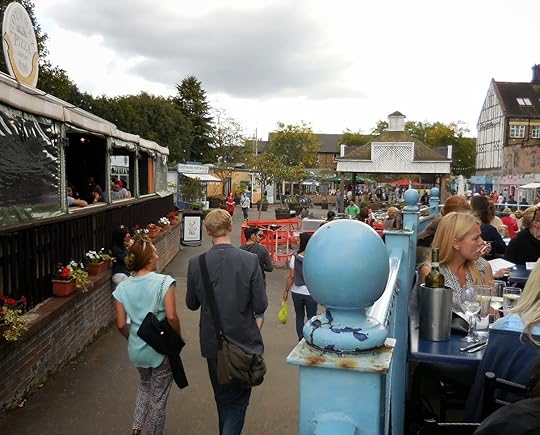
As usual, Gabriel's Wharf, a shopping and dining destination, was doing a brisk business. We settled upon the Wharf Restaurant
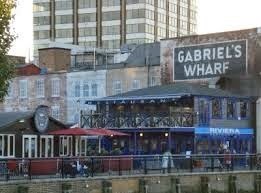
And it wasn't long before we were tucking in to a plate of mushroom risotto accompanied by glasses of crisp, cold prosecco.
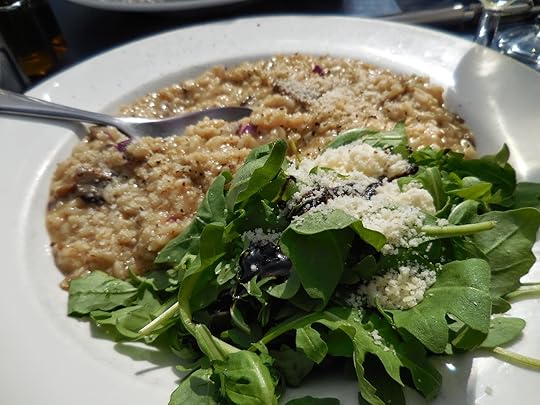
After lunch, we needed to get back across the River, so we walked out the back of the Wharf to a street known as the Upper Ground. This is where the docks once stood where, once upon a time, the streets teemed with a decidedly rough and ready trade - sailors who had just docked after months at sea and who were looking to let loose, ladies of the night (or day) looking to make a bit of coin, foreigners of all sorts seeking to sell or buy cargoes of exotic goods, street hawkers, cab men, coster mongers, fishermen, boatmen, etc. etc. The ships drove the neighborhood and the streets would have been awash in people of all stripes. Today, however, these were the sights we were met with.
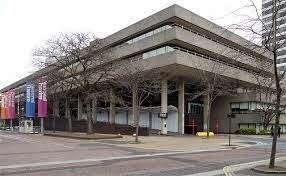
ITV Studios
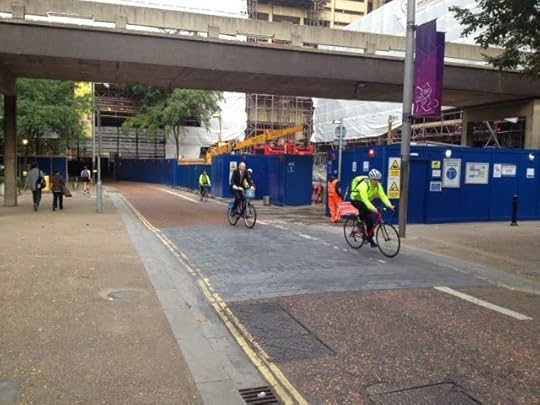
Of course, this is more the way I was picturing it in my mind
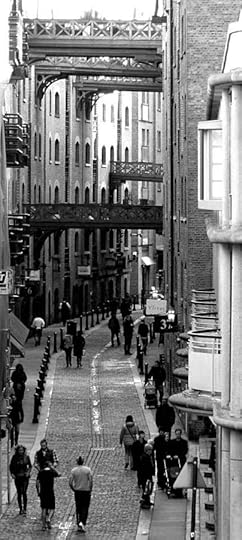


"Where are we going?" Victoria finally asked.
"Waterloo. Station. And the Duke of Wellington Pub."
"Do you know the story about Churchill and Waterloo Station?" Victoria asked me.
"I don't think so."
"Before he died, Churchill worked on the plans for his own funeral. He was going to be buried at St. Martin's Church in Bladon, in Oxfordshire, where many members of the Spencer Churchill family had been buried."
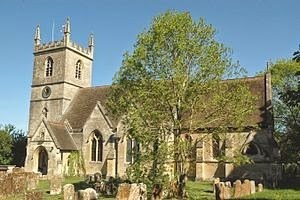
"So," Victoria went on, "Churchill's funeral cortege would have traveled to Oxford by train. And trains to Oxford leave from which London station?"
"Paddington," I answered.
"Exactly. But Churchill asked if it would be possible for his funeral train to depart from Waterloo Station, instead. Certainly, and official told him. It would mean diverting tracks and re-route thousands of daily tube passengers, it would involve redirecting signals and a host of other alterations, but in theory it could be done. Looking pleased, Churchill told him to arrange it when the time came. But why, asked official. What did Churchill have against Paddington Station? Nothing, he replied, but no doubt other countries would send heads of state to attend the funeral. France would no doubt send a representative, to which the official agreed. "Well," Churchill said, "I don't want to pass up the opportunity to force French President de Gaulle to have to walk through Waterloo Station."
"Are you making this up?"
"No," Victoria laughed, "If it isn't true, it should be. Where are we going? Are you sure Waterloo Station down this way? It doesn't look right."
"The last time I walked this way, I wound up at Waterloo. It's just down here," I said, pointing.
Two girls were passing and Victoria asked them if this were the way to Waterloo Station. They told that indeed it was, and pointed in the direction I'd just indicated.
"Oh, ye of little faith," I said. "And look, there's the Wellington Pub. They haven't moved that, either."


Of course, this was the perfect opportunity for a photo op. Note the people in summer wear in the background.

And then take note of my fur lined boots!

Another summery sign seen outside of Waterloo Station

And believe it or not, this is the poster we were met with inside the station, advertising the Wellington Exhibit we'd planned to see at the Tower. Nice to know I had unconsciously dressed to match Wellington's uniform. He had Wellies, I have fur lined boots.
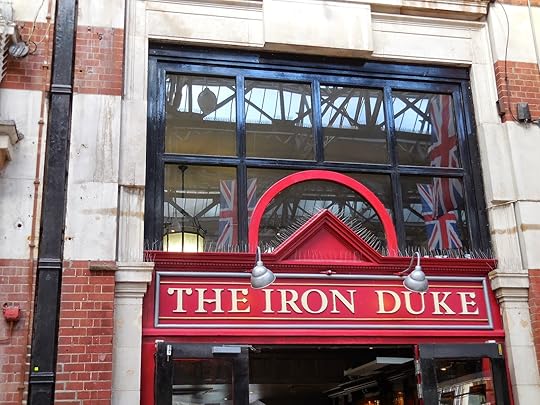
Getting off of the tube at Victoria Station, Victoria and I were met with this pub, located inside the Station. We popped our heads inside, but it was sadly uninspiring and without much period charm. We walked through the Station and found the entrance to the Grosvenor Hotel, where we'd all be staying for the first leg of the Duke of Wellington Tour.
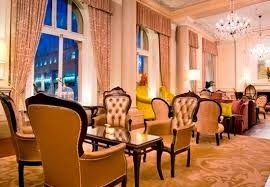
As you'll see by the photo above, we were quite satisfied after inspecting the room in which we'd be holding our Welcome afternoon tea for our tour participants.
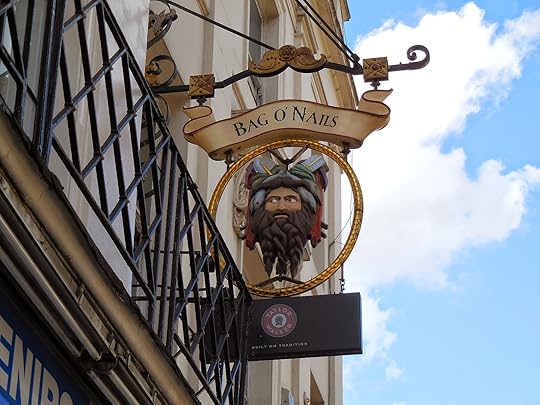
With still more on the day's schedule ahead, we headed out onto Buckingham Palace Road and headed towards Buckingham Palace, passing one of our old haunts, the Bag O' Nails pub, along the way.
Before long, we'd reached the Queen's Gallery, where Victoria and I have attended many an exhibition. There's another old haunt of ours just outside the Gallery - a long, low wall just perfect for resting upon, so we decided to take a short sit before going on.
After our break, we carried on, finally reaching the front of the Palace.
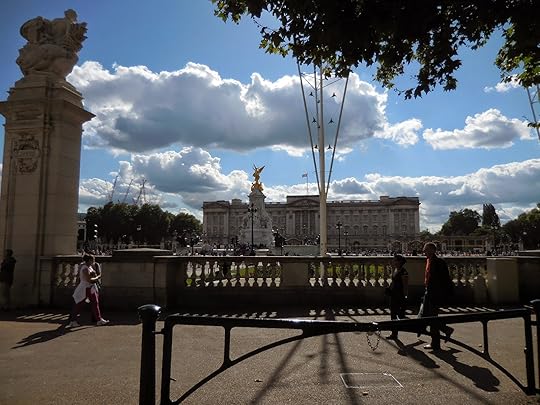
It was here that Victoria realized she'd left her camera back at the stone wall. I volunteered to go back for it and fast walked back the way we'd come, only to find the camera gone! A man saw me looking for something and volunteered that if it was a camera, he'd handed it in at the front desk inside the Queen's Gallery - thank goodness!

Returning both the camera and myself to Victoria, we turned and started up the Mall, which was free of vehicle traffic as this was a Sunday.
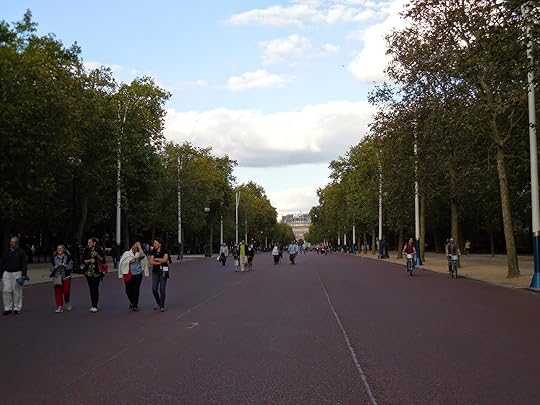 The Mall on Sunday
The Mall on Sunday Flowers in the gardens bordering the mall
Flowers in the gardens bordering the mall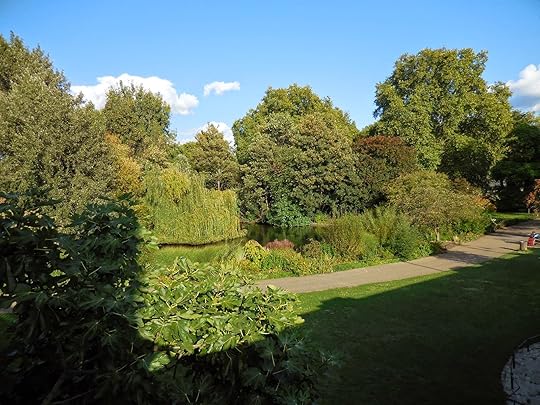 the pond along the MallEventually, we reached Green Park, where we turned left and walked up to Milkmaid's Passage, which brought us out near Spencer House and across from Duke's Hotel.
the pond along the MallEventually, we reached Green Park, where we turned left and walked up to Milkmaid's Passage, which brought us out near Spencer House and across from Duke's Hotel. 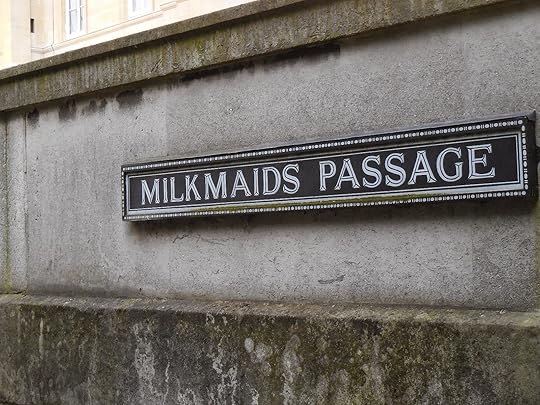
This is the lane, or alleyway, that servants from the aristocratic houses in St. James's used in order to cut across to Green Park in order to buy milk from the cow keepers who sold milk by the pailful.

Just behind Milkmaids Passage stands Lancaster House, above, where, in 1848, Chopin entertained Queen Victoria, Prince Albert and the Duke of Wellington. You'll find more on the history of Lancaster House here.
Before long, Victoria and I arrived at Clarence House, below, in time for our 4 p.m. guided tour.
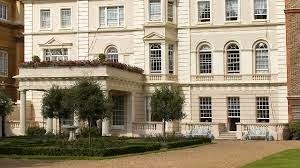 Clarence House
Clarence HouseMore Loose in London Coming Soon!
Published on January 25, 2015 23:30
January 23, 2015
SONS OF LIBERTY
Published on January 23, 2015 23:30
January 22, 2015
THE WELLINGTON CONNECTION: LORD BRIDGEWATER
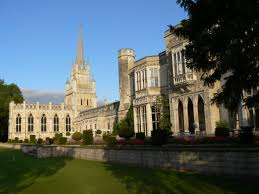
From the Journal of Mrs. Arbuthnot - January 23, 1822: We went to Ashridge (Lord Bridgewater's in Hertfordshire) to meet the Duke of York and a large shooting party. The house has been totally built by Lord Bridgewater; it is modern Gothic, which I do not admire, but altogether it is certainly very fine; the rooms are magnificent, very finely proportioned and beautifully finished, the staircase is very fine indeed and highly ornamented. . . . The flower gardens and conservatories are beautiful and the whole establishment worthy of a great nobleman and an excellent good man. Lord Bridgewater employs 500 men all the year round upon his estate and makes it a rule never to refuse work to any who apply for it, and he frequently has 800 men in his pay. The shooting was excellent; Lord Londonderry was generally at the head and one day killed 107 head. The Duke of Wellington killed above 80 one of the days. I played whist in the evening with the Duke of York against the Duke of Wellington, whose luck at cards is quite extraordinary. It seems as if his good genius accompanied him in every, the most trivial concerns of life. Lady Bridgewater, one of the mornings, took Lady Londonderry and me all over the work shops where they were carving wood and stone ornaments for the chapel, which is certainly the chef-d'oeuvre of the house.
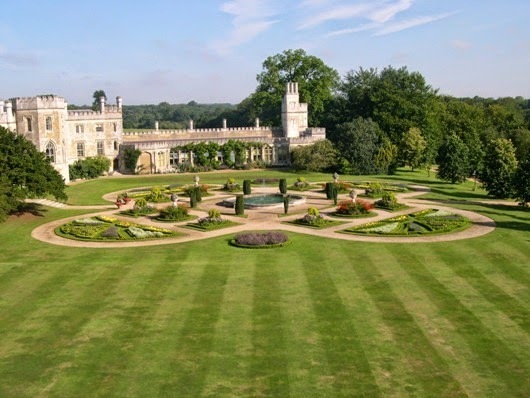
Published on January 22, 2015 23:30
January 20, 2015
VIDEO WEDNESDAY: HISTORY COLD CASE
Aired on BBC Two, History Cold Case is a series that sees the skeletons of everyday people from across the ages analysed in staggering detail, opening new windows on the history of our forebears by literally revealing the person behind the skeleton.
This is a fabulous series, with each episode bringing the daily lives, times and history surrounding each skeleton to life. Wonderful for history lovers and medical enthusiasts. Many thanks to Jo Manning for bringing this to our attention!
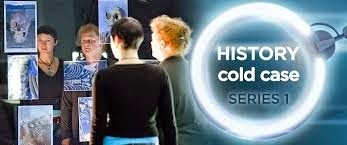
You'll find the link to the full playlist here.
More about the series:
The fascinating work of world-renowned Professor Sue Black OBE and her team at the Center for Human Anatomy and Identification at the University of Dundee comes under the spotlight as the team works on answering three big questions from the skeleton.Who were they? Why did they die? What does their life story tell us that we didn't know before? Using the full arsenal of modern forensic anthropology, remarkable stories emerge from long forgotten bones, along with the faces of people who haven't been seen for hundreds of years.Ipswich Man. An apparently African skeleton, unearthed near a medieval English monastery, pushes Professor Sue Black's forensics team to its limits.Mummified Child. This time the team heads back into a dark corner of the 19th century, to a time when corpses were turned into trophies and children were sold by the inch.Stirling Man. Mysterious skeleton discovered by accident in a series of forgotten rooms in Scotland's Stirling Castle.Crossbones Girl. A skeleton unearthed in an archaeological dig in the historic borough of Southwark in London sparks a new cold case when it is found to be covered with disfiguring scars.The Skeletons of Windy Pits. For decades experts have remained baffled by a jumble of human bones discovered in a unique series of caves on the North York Moors, known as the Windypits.The York 113. In 2008, construction workers just beyond York's city walls uncovered 113 bodies in a mass grave.The Bodies in the Well. When the remains of 17 people - men, women and 11 children, one as young as two years old - were discovered in a dry well shaft in Norwich city centre, the local community were keen for answers about who these people were and what happened to them.The Woman and Three Babies. In the sleepy commuter town of Baldock in Hertfordshire the History Cold Case team is called in to investigate the discovery of a skeleton dating from around 100AD, buried in a bizarre position, along with the remains of three babies.
Published on January 20, 2015 23:30
January 18, 2015
LOOSE IN LONDON: KRISTINE MUSES ON MUDLARKING
You may recall a prior post about mudlarking on the River Thames that I wrote a few years ago - you'll find it here. I had been longing to return to the River again and was chuffed when Victoria said she'd like to take a turn at mudlarking while we were in London.
Victoria and I started out as part of a London Walks mudlarking tour on Sunday morning, with at least thirty other people in our group. The group was so big that the guide and her assistant broke us up into two groups, while she went back and forth relating the history of the Thames, it’s bridges and, incidentally, mud larking. This went on for quite some time before Victoriasidled up and asked me if we were ever going to get the opportunity to actually get our hands dirty, so to speak. After all, we were almost an hour into the walk and we were still on the northern side of the river.
Finally, we got across the Thamesand no sooner had we arrived then we lost the tour group. Both tour groups, in fact. The guide had organized us, in two groups, around a set of steps while she told us about something to do with shipping history. Victoria and I had only briefly wandered away and when we turned back, all thirty-something of them had vanished. Considering the size of the two groups, it was uncanny that we could find no sign of any of them. Poof! and they were gone. This did not bode well for our own turns as tour guides in the not too distant future.

“What are we going to do now?” Victoria asked, a tad worried.
“We go mud larking, as planned.”
“But where?”
“Anywhere. There are several sets of stairs on this side of the Thames that lead down the river. If the gate at the top of the steps is unlocked, all we have to do is climb down to the river bank.” I looked over the railings on the Queen’s Walk to the riverbed below. “Look,” I said, pointing at some near distant mud larkers. “They’ve gotten themselves down there, we can, too.”
“Are we allowed? I mean, can we just go down at any point, or is there a designated mud larking spot?”
“Well, no one’s ever stopped me before. If a Peeler with a truncheon comes along and threatens to haul us in as vagrants, we’ll move on. Come on, we’ll go down to the steps that Brooke and I used last time. I know they’re accessible.”
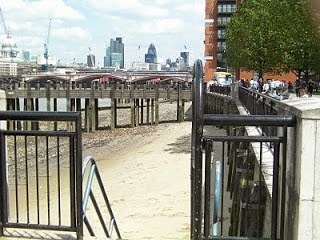
So we walked down to the spot in question and sure enough, the gates were unlocked. Not only that, but there was some sort of Clean Up the River type event going on, so there were several people picking through the sand already. Vicky and I got out our Ziploc bags and climbed down the stairs.
“You want to pick through the stuff at the top here, near the wall and stairs. Everyone typically heads for the waterline first, and they walk right past some good stuff. Here,” I went on, ”take this stick and use it to push the sand aside.” Within minutes, Vicky was mud larking like a pro, searching for blue and white pottery shards and anything else of interest. I found myself a large, flat shell and used that to dig with.

Here's a photo of me on the River bank, wearing my now famous fur lined boots. Before long, Victoria and I had drifted apart. Her wanderings took her in one direction, mine in another as we both dug through a few decades, if not centuries, of silt and sand.
I love standing on the river bank with the tide out, exposing bits of Londononly a few people get to see. It’s a way of communing with London, of getting to the heart of the City I love best. It isn't glamorous, rather it's real life at its most rough and ready. At one time, it was home to those who were London’s poorest – the mud larks who combed this stretch of river bank in search of anything of any value that they could turn into coin for a meal or a bed for the night. Just think of all of their stories, the tales that could be told by people who sailed the river, worked the river, whose lives were tied in some way or another to the eternal rhythm, the ebb and flow of the mighty Thames.
I'll always remember seeing the opening scenes in one of the Robert Downey Jr. Sherlock Holmes films - the London docks of the 19th century. Never had I seen movie set that looked so exactly as I had always pictured a place in my mind's eye. I felt that what I was looking at was 19th century London, magically brought to life on the screen. Imagine my dismay when I later found out that the scenes had actually been shot at Stanley Docks in Liverpool. Here's a trailer from the film - there's actually very little of the docks in the clip, but it's a hoot.
You'll see from the photos below that it was glorious London day, perfect weather for being outdoors. This is what the riverbank looked like when we were there.

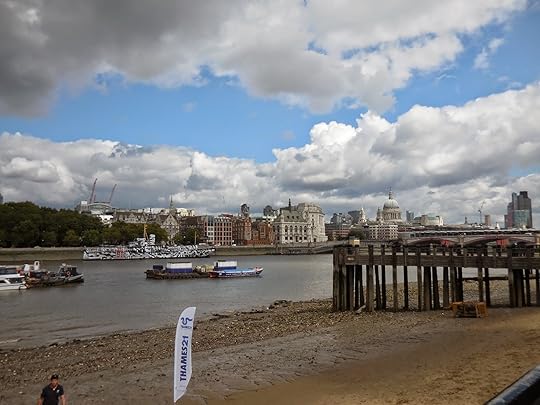
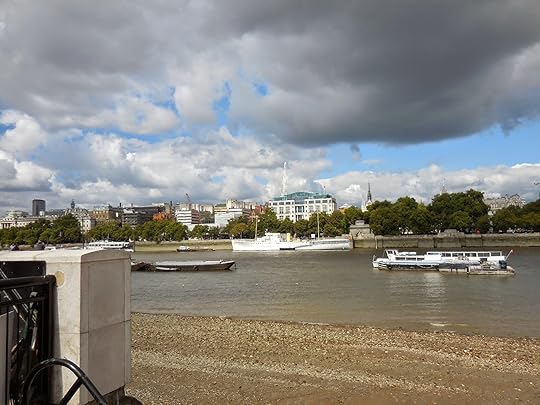
However, this is what I saw in my mind's eye as I gazed out at the Thames.

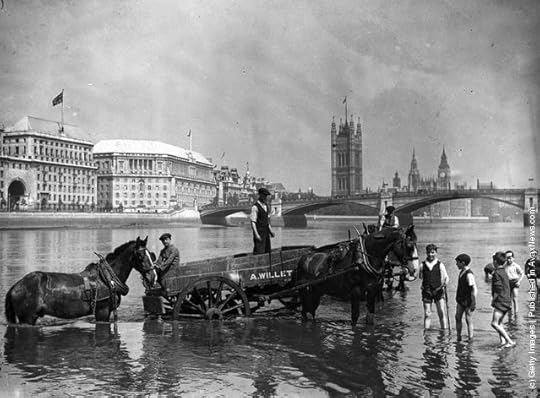

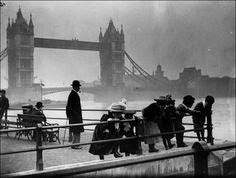
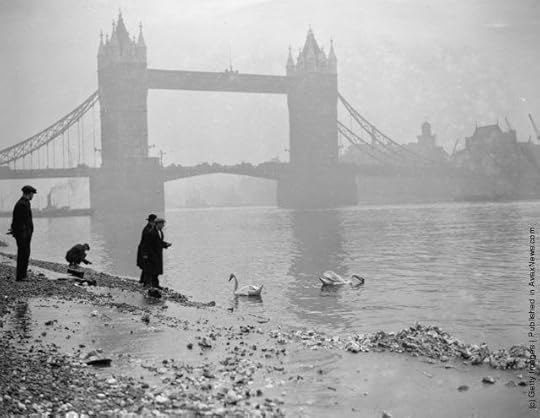
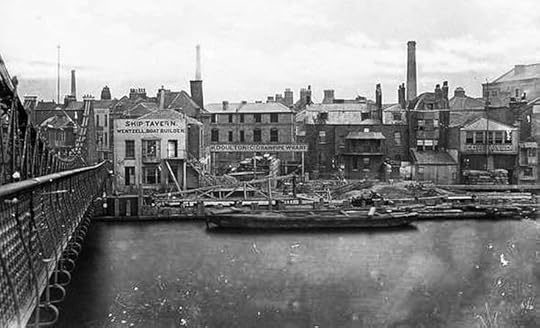
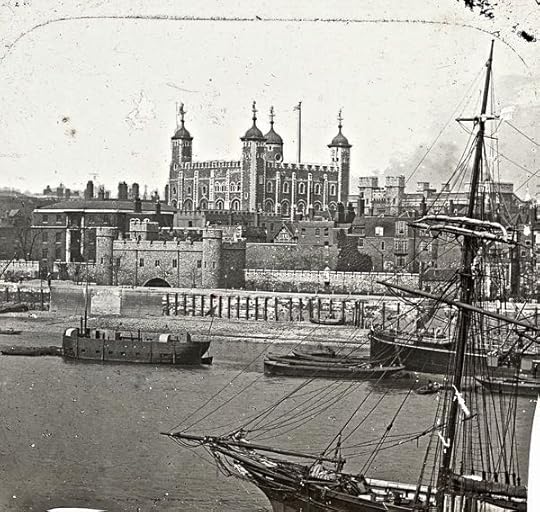

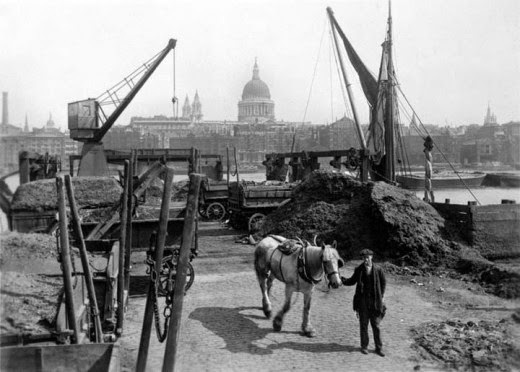

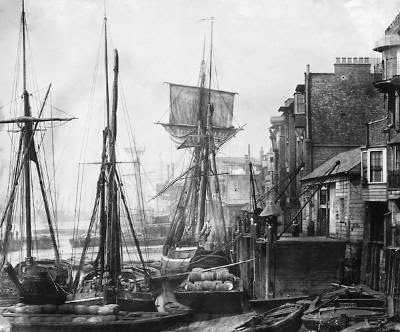
Yes, Victoria, I was picturing a place where everyone was wearing period costume. And sailing in period ships.
Back in the 21st century, Victoria and I had a fabulous time collecting treasures from the River. Pottery shards, pipe stems and bowls, animal bones, driftwood, bits of metal and, most surprisingly, shells. We spent not a few hours treasure hunting before I looked up to see Victoriafurther ahead, waving an arm at me in a universal gesture that meant "get over here."
"We've got to wrap things up," she said when I'd reached her. "We need to eat something and then make our way over to Clarence House." We'd booked a tour of Clarence House for four o'clock that afternoon, another place we'd always wanted to see, but which is rarely open to the public.
Reluctantly, I agreed but stopped by the station the Clean Up the Thames group had set up nearby. In addition to the sand sculptures below, they had set up a table manned by River historians and archaeologists who were available to a provide insight into the items people had found that day.
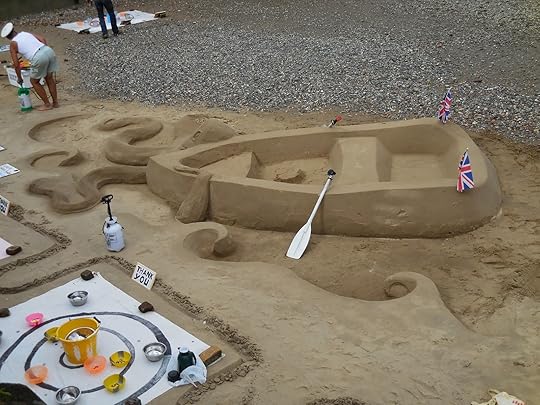
I showed them the bones I had found and their best guess was that they had probably come from a dog.
My pottery shards were fairly self explanatory.
The pipe stems and pipe bowl I'd found were a different story. They actually had a book with them containing pipes of all periods and going by the shape and size of my pipe, they were able to tell me that mine was early 18th century. The photo above doesn't do justice to the pipe bowl, it has a very elaborate design carved into the bowl. The expert was much taken with it and told me that it had to have belonged to someone of means. These pipes were meant to be disposable. One bought one already filled with tobacco, smoked it and chucked it away, many times into the River.. They weren't typically the sort of item one spent time carving designs into. He was quite impressed and I was dead chuffed.
Perhaps my most interesting find was this tooth. I'm holding it upside down so that you can see the three rather large roots. The consensus is that it had probably come from a horse.
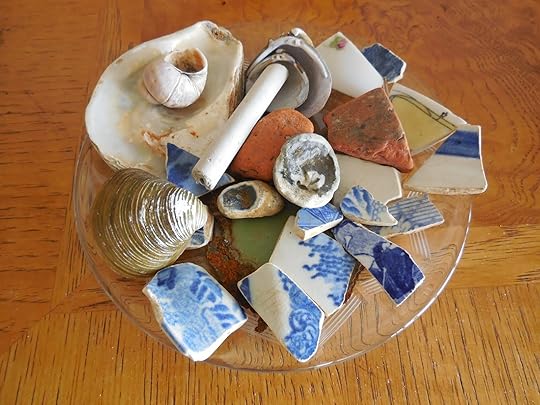
Victoria's treasures were much prettier and are pictured above: shells, clay pipe stem, blue-and-white shards, tile pieces.
You'll find the black and white River photos above and many more period photos of all areas of London and London life on my Pinterest board, Old London.
More Loose in London Coming Soon!
Published on January 18, 2015 23:30
Kristine Hughes's Blog
- Kristine Hughes's profile
- 6 followers
Kristine Hughes isn't a Goodreads Author
(yet),
but they
do have a blog,
so here are some recent posts imported from
their feed.


